Black & Decker BXUP250PCE, BXUP750XCE, BXUP1100XDE, BXUP750PTE Manual
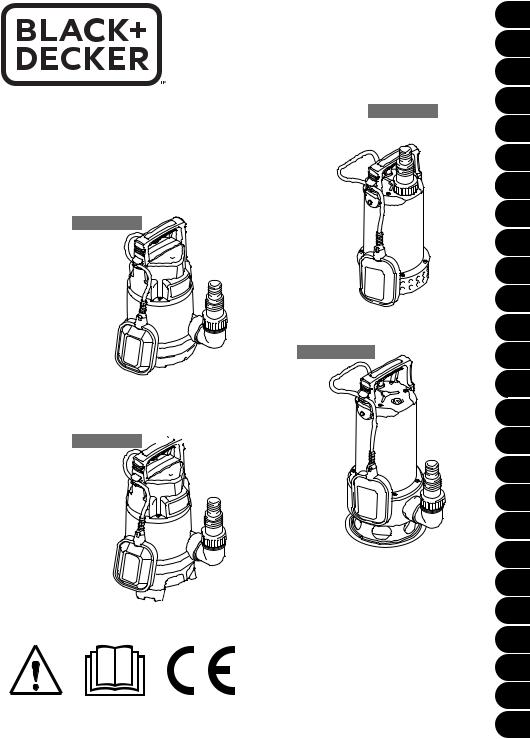
BXUP750XCE
BXSP1100XDE
BXUP250PCE
BXUP1100XDE
BXUP750PTE 



BXUP250PCE
BXUP750PTE
BXUP750XCE
BXUP1100XDE
cod. 94146 - HN |
www.blackanddecker.eu |
|
|
EN
IT
BG CS DA DE EL ES ET FI FR HR HU LT LV NL NO PL PT RO RU SK SL SV TR UK
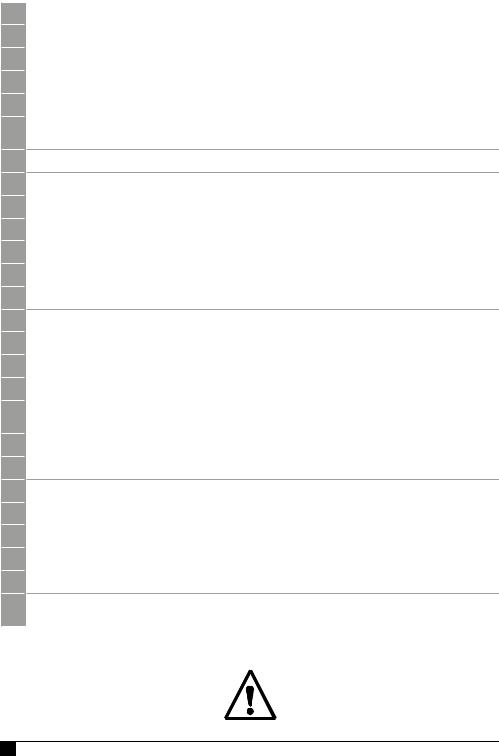
EN
IT
BG
CS
DA
DE
EL
ES
ET
FI
FR
HR
HU
LT
LV
NL
NO
PL
PT
RO
RU
SK
SL
SV
TR
UK
Please read these instructions carefully before use. Please retain these instructions for future reference. |
|
In case of problems or difficulties, please contact the consumer helpline: www.2helpu.com |
Page: 5-12 |
Leggere attentamente queste istruzioni prima dell’uso. Conservare queste istruzioni per future consultazioni. |
|
In caso di problemi o difficoltà, contattate l’helpline consumatori: www.2helpu.com |
Pagina: 13-22 |
Прочетете внимателно тези указания преди употреба. Запазете тези указания за справка. |
|
При проблеми или затруднения се обърнете към отдела за обслужване на клиенти: www.2helpu.com |
Страница: 23-32 |
Před použitím si pozorně přečtěte tento návod. Laskavě si uložte tento návod pro budoucí použití. |
|
V případě jakýchkoli problémů nebo potíží laskavě kontaktujte linku pomoci zákazníkům: www.2helpu.com |
Strana: 33-40 |
Læs disse instruktioner omhyggeligt inden brug. Opbevar disse instruktioner til senere brug. |
|
Kontakt kundeservicetelefonen i tilfælde af problemer eller vanskeligheder: www.2helpu.com |
Side: 41-49 |
Lesen Sie bitte diese Bedienungsanleitung vor Gebrauch aufmerksam durch. |
|
Bewahren Sie diese Bedienungsanleitung sorgfältig auf, damit Sie sie auch später zu Rate ziehen können. |
|
Wenden Sie sich im Falle von Problemen bitte an die Verbraucher-Hotline: www.2helpu.com |
Seite: 50-59 |
Διαβάστε προσεκτικά αυτές τις οδηγίες πριν από τη χρήση. Φυλάξτε αυτές τις οδηγίες για μελλοντικές αναφορές.
Σε περίπτωση προβλημάτων ή δυσκολιών, επικοινωνήστε με τη γραμμή helpline υποστήριξης καταναλωτών: www.2helpu.com Σελίδα: 60-69
Leer atentamente estas instrucciones antes de usar el equipo. Guardar estas instrucciones para poder consultarlas en el futuro.
En caso de problemas o dificultades, ponerse en contacto con el servicio de asistencia al cliente: www.2helpu.com |
Página: 70-78 |
Enne kasutamist lugege see juhend tähelepanelikult läbi. Hoidke juhend hilisemaks kasutamiseks alles. |
|
Probleemide või raskuste ilmnemisel pöörduge klienditoe poole: www.2helpu.com |
Lk: 79-86 |
Lue ohjeet huolellisesti ennen käyttöä. Säilytä ohjeet huolellisesti tulevaa käyttöä varten. |
|
Jos kohtaat ongelmia, ota yhteys kuluttajien helpline-palveluun: www.2helpu.com |
Sivu: 87-94 |
Lire attentivement ces instructions avant emploi. Conserver ces instructions pour toute consultation à venir. |
|
En cas de problèmes ou de difficultés, contacter l’assistance consommateur : www.2helpu.com |
Page : 95-104 |
Molimo vas da prije uporabe pažljivo pročitate ovaj priručnik. Sačuvajte ove upute za buduće korištenje. |
|
Ako naiđete na kakve probleme ili poteškoće, molimo vas da se obratite službi za podršku korisnicima: www.2helpu.com |
Stranica: 105-112 |
A készülék használatba vétele előtt gondosan olvassa el az útmutatót. A későbbi hivatkozások érdekében őrizze meg az útmutatót. |
|
Kérdés vagy probléma esetén forduljon ügyfélszolgálatunkhoz: www.2helpu.com |
113-121. oldal |
Prieš pradėdami naudoti įrenginį, atidžiai perskaitykite šias instrukcijas. Išsaugokite šias instrukcijas, kad bet kada galėtumėte jas vėl perskaityti.
Jei kyla problemų arba sunkumų, kreipkitės į klientų pagalbos liniją: www.2helpu.com |
Puslapiai: 122-129 |
Pirms lietošanas, lūdzu, rūpīgi izlasiet šo pamācību. Lūdzu, saglabājiet šos norādījumus turpmākai uzziņai. |
|
Ja rodas kādas problēmas vai grūtības, lūdzu, sazinieties ar klientu palīdzības dienestu: www.2helpu.com |
Lappuse: 130-137 |
Lees deze gebruiksaanwijzing vóór het gebruik aandachtig door. Bewaar deze gebruiksaanwijzing voor latere raadpleging. |
|
Contacteer bij problemen of moeilijkheden de hulplijn voor de gebruikers: www.2helpu.com |
Pagina: 138-147 |
Les disse instruksjonene nøye før bruk. Ta vare på instruksjonene for senere bruk. |
|
Ved problemer eller vanskeligheter, kontakt kundeservice: www.2helpu.com |
Side: 148-155 |
Przed użyciem należy uważnie przeczytać niniejszą instrukcję obsługi. Instrukcję należy zachować na przyszłość. |
|
W razie jakichkolwiek problemów lub trudności można skontaktować się z działem pomocy technicznej pod adresem: |
|
www.2helpu.com |
Strona: 156-165 |
Leia atentamente estas instruções antes de utilizar o aparelho. Conserve estas instruções para consultas futuras. |
|
Em caso de problemas ou dificuldades, contacte a helpline de atendimento aos consumidores: www.2helpu.com |
Página: 166-175 |
Vă rugăm să citiţi cu atenţie aceste instrucţiuni înainte de utilizare. Vă rugăm să păstraţi aceste instrucţiuni pentru consultarea pe viitor. |
|
În caz de probleme sau dificultăţi, vă rugăm să contactaţi linia de asistenţă a clienţilor: www.2helpu.com |
Pagina: 176-184 |
Внимательно прочитайте эти инструкции до начала использования. Сохраните инструкции для пользования ими в будущем.
При появлении проблем или затруднений обращайтесь в отдел обслуживания клиентов: www.2helpu.com |
Страница: 185-194 |
Pred použitím si, prosím, pozorne prečítajte tento návod. Tento návod si odložte na použitie v budúcnosti. |
|
Ak narazíte na akékoľvek problémy alebo ťažkosti, obráťte sa na linku pomoci pre zákazníkov: www.2helpu.com |
Strana: 195-202 |
Pred uporabo pazljivo preberite ta navodila. Ta navodila shranite za prihodnjo uporabo. |
|
Če naletite na težave, se obrnite na službo za pomoč kupcem: www.2helpu.com |
Stran: 203-210 |
Läs bruksanvisningen noggrant före användning. Förvara bruksanvisningen för framtida bruk. |
|
Vid ev. problem eller frågeställningar, kontakta kundtjänst på www.2helpu.com |
Sid.: 211-219 |
Kullanmadan önce, bu talimatları dikkatlice okuyunuz. Bu talimatları, ileride danışmak için saklayınız. |
|
Problem veya zorluk durumunda, tüketici yardım hattına başvurunuz: www.2helpu.com |
Sayfa: 220-228 |
Перед експлуатацією уважно прочитайте цю інструкцію. Зберігайте цю інструкцію для подальшого використання в довідкових цілях. У разі виникнення проблем або труднощів звертайтеся до нашої служби підтримки: www.2helpu.com
2
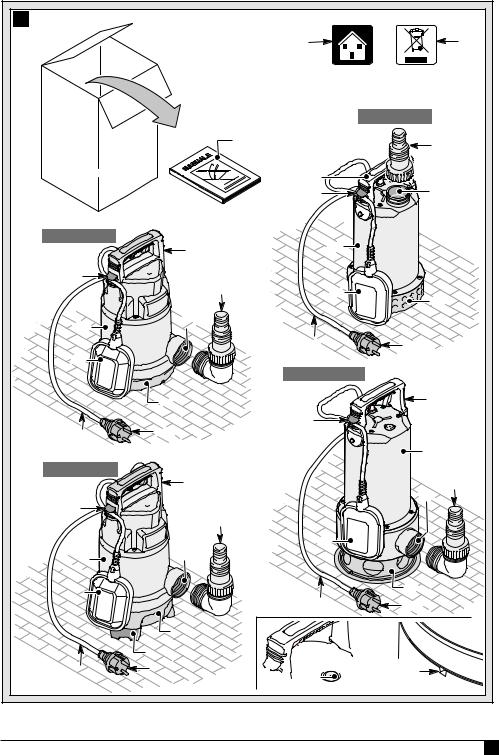
1 |
|
|
|
|
|
|
|
E3 |
E1 |
|
|
|
|
BXUP750XCE |
|
|
|
D1-D2-D3 |
A3 |
|
|
|
|
|
|
|
|
A4b |
A2 |
|
|
|
A5b |
|
BXSP1100XDE |
|
|
|
|
BXUP250PCE |
A4b |
|
A4 |
|
|
|
|
||
|
|
|
|
|
A5b |
|
A3 |
|
|
|
|
A5 |
A1 |
|
|
|
|
||
|
|
|
|
|
A4 |
A2 |
|
|
|
|
|
|
|
|
|
|
|
A8 |
A12 |
A5 |
|
|
BXUP1100XDE |
|
|
|
|
||
|
A1 |
|
|
A4b |
|
A12 |
|
A5b |
|
A8 |
|
|
|
|
|
|
|
|
|
|
|
|
|
A4 |
BXUP750PTE |
A4b |
|
|
A3 |
|
|
|
||
A5b |
|
|
|
A2 |
|
A3 |
|
|
|
|
|
|
|
|
|
A2 |
|
A5 |
|
A4 |
|
|
|
|
|
|
|
|
|
A5 |
|
|
|
A1 |
|
|
A8 |
A12 |
|
|
|
|
||
|
A1 |
|
|
|
|
A6 |
|
|
|
A8 |
A12 |
|
A7 |
A7 |
|
|
|
|
|
3
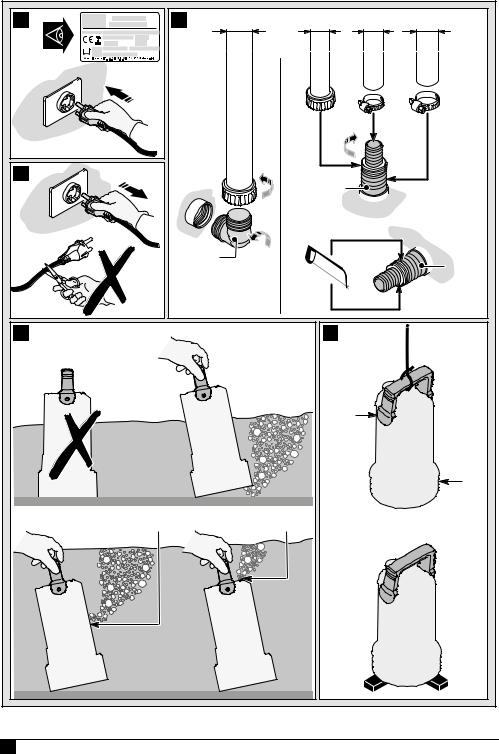
2 |
4 |
G 1”1/2 |
G 1” |
Ø 1” |
Ø 1”1/4 |
|
|
|
A3 |
|
|
|
|
A3 |
|
|
A3 |
|
|
|
|
|
|
5 |
|
|
6 |
|
|
|
|
|
A4b |
|
|
|
|
|
|
|
A1 |
|
A7 |
|
A7 |
|
|
4 |
|
|
|
|
|
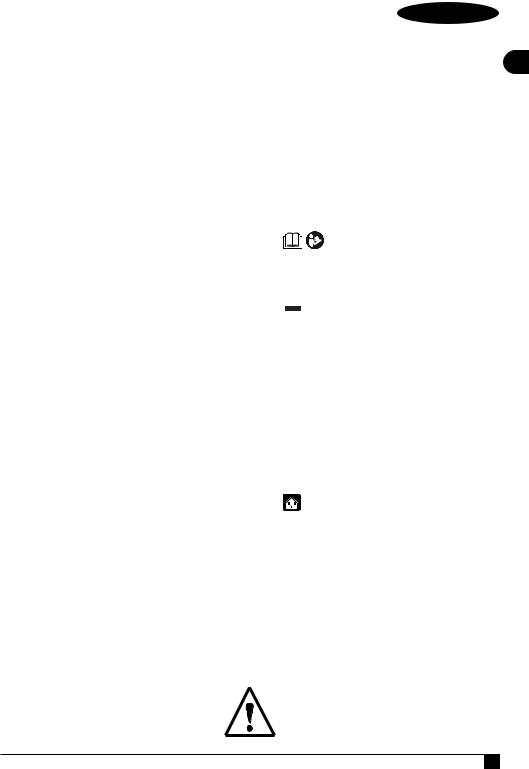
1 SAFETY INSTRUCTIONS
1.1The appliance you have purchased is produced by one of Europe's top manufacturers of household and gardening pumps. Our appliances are not designed to withstand the stresses typical of commercial or industrial use, or for continuous duty. You must know and comply with the instructions provided in this manual to get the most from your pump. During connection, use and servicing of the appliance, take all possible precautions to protect your own safety and that of the people in the immediate vicinity. Read the safety regulations carefully and comply with them strictly; failure to do so may put health and safety at risk or cause expensive damage. The manufacturer is not responsible for any damage caused by incorrect or improper use.
(Original instructions) |
ENGLISH |
2 SAFETY DECALS / INFORMATIVE |
|
DECALS |
EN |
2.1Comply with the recommendations of the decals affixed to the appliance. Check that they are present and legible; otherwise, fit replacements in the original positions.
 Warning - Danger
Warning - Danger
Pleasereadtheseinstructions carefully before use.
 Symbol E1. The appliance must not be disposed of as household waste; it may be returned to the dealer on purchase of a new appliance. The appliance’s electrical and electronic parts must not be reused for improper uses because they contain substances which constitute
Symbol E1. The appliance must not be disposed of as household waste; it may be returned to the dealer on purchase of a new appliance. The appliance’s electrical and electronic parts must not be reused for improper uses because they contain substances which constitute
health hazards.
Symbol E3. Indicates that the appliance is intended for
household use.
5
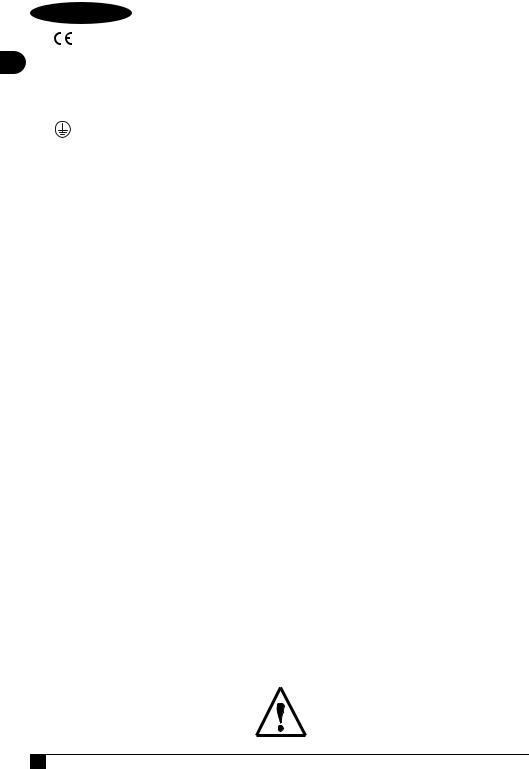
ENGLISH |
(Original instructions) |
EN
CE Symbol. Indicates that the appliance complies with the
relevant EU directives.
This produce is rated in insulation class I. This means that it is equipped with a protective earthing conductor (only if the symbol
appears on the appliance).
6
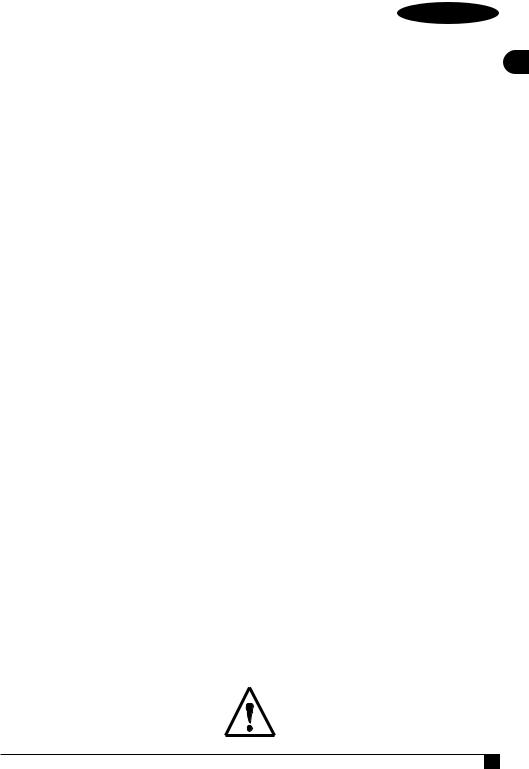
(Original instructions) |
ENGLISH |
3 SAFETY RULES / RESIDUAL RISKS |
|
3.1 SAFETY PRECAUTIONS: DO NOTS |
EN |
3.1.1Injury hazard! DO NOT allow the appliance to be used by children or persons with impaired physical, sensory or mental capabilities, or who do not have the necessary experience and knowledge. Children must not use the appliance as a toy. Cleaning and user maintenance must not be carried out by children.
3.1.2Explosion or poisoning hazard! Never use the appliance with flammable, toxic or aggressive liquids, or liquids with characteristics incompatible with its proper operation.
3.1.3Injury hazard! Do not point the water jet at people or animals.
3.1.4Electrocution hazard! Do not point the water jet at the appliance, electrical parts or other electrical devices.
3.1.5Short-circuit hazard! Do not use the appliance outdoors in the rain. This does not apply to submersible pumps, which may also be used in the rain; however, it is essential to ensure that the connections of the plug (A12) and any extension leads used are protected from water splashes and flooding.
3.1.6Injury hazard! Do not allow the appliance to be used by children, persons with impaired physical, sensory or mental capabilities, or any unauthorised persons.
3.1.7Electrocution hazard! Do not touch the plug (A12) and/or socket with wet hands.
3.1.8Electrocution and short-circuit hazard! If the power cable (A8) is damaged, it must be replaced by the manufacturer, one of its authorised Service Centres or similarly qualified persons in order to prevent all risks.
3.1.9Explosion hazard! Do not use the appliance if the suction or delivery hose is damaged.
3.1.10Injury hazard! Place the appliance in a stable position; when using the appliance in the vicinity of swimming-pools, garden ponds or other outdoor bodies of water, keep it at least 2 m from the water's edge and protect it from falling into the water or flooding. This does not apply to submersible pumps, since they can be used immersed in water.
3.1.11Injury hazard! Check that the appliance is fitted with the data plate which carries its specifications; contact your dealer at once if it is missing. Appliances without data plate must not be used, since they cannot be identified and are potentially hazardous.
3.1.12 Explosion hazard! No adjustment of control valves, safety valves or other safety devices, or tampering with their settings, is permitted.
7
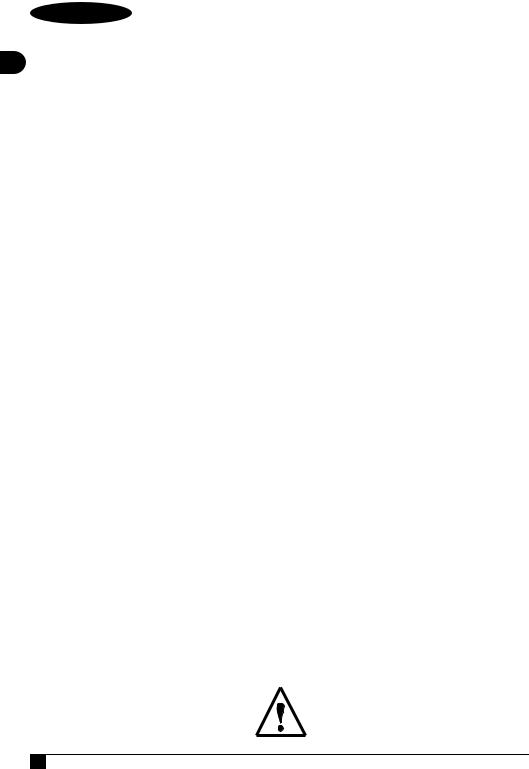
|
ENGLISH |
(Original instructions) |
|
3.1.13 Scalding hazard! In the event of a pressure switch malfunction or water supply failure, the water left |
|
EN |
inside the pump body (A4) may overheat and cause scalding when discharged. |
|
3.1.14Injury hazard! Do not use the appliance unattended if there is the risk of fouling.
3.1.15Short-circuit hazard! Do not move the appliance around by pulling the plug (A12), the power cables (A8) or other connection fixtures; use the handle (A4 b).
3.1.16Explosion hazard! Do not allow vehicles to drive over the suction or delivery hose. Do not drag or transport the appliance by the suction or delivery hose.
3.1.17Injury hazard! Do not use the appliance when people or pets are in the pumped liquid, or may come into contact with it.
3.2SAFETY PRECAUTIONS: MUSTS
3.2.1Short-circuit hazard! All electrical conductors must be protected from splashes of water.
3.2.2Electrocution hazard! Only connect the appliance to an electrical power source compliant with the relevant standards (IEC 603641-1); during start-up, the appliance may generate interference on the electrical system. Only connect the appliance to a socket fitted with a residual current device rated at 30 mA or less. Use only electrical extension leads compliant with the relevant regulations, approved for outdoor use and with gauge at least equal to that of the appliance's power cable. Power cables wound onto reels must be completely unwound.
3.2.3Danger! The appliance must never operate dry; always fill the pump body (A4) with water before starting it. Even a short period of operation without water may cause damage.
3.2.4Accidental switch-on hazard! Always disconnect the plug (A12) from the power socket before carrying out any work on the appliance.
3.2.5Danger! To guarantee the appliance's safety, the maximum temperature of the pumped liquid must not exceed 35°C. The ambient temperature must not drop below +5°C.
3.2.6Danger! The appliance is not designed to pump drinking water or water for human consumption. The pumped water may be contaminated by lubricant leaks.
3.2.7Injury hazard! Maintenance and/or repair of the appliance or electrical components must only be carried out by specialist staff.
3.2.8Injury hazard! Discharge residual pressure before disconnecting the hose from the appliance; to do this, disconnect the appliance from the electricity supply and open a user outlet.
3.2.9Injury hazard! Before use, and at regular intervals, inspect the accessories and check the appliance's components for signs of failure and/or wear.
8

4 GENERAL INFORMATION
4.1 Use of the manual
This manual forms an integral part of the appliance and should be kept for future reference. Please read the manual carefully before installing/ using the appliance. If the appliance is sold, the seller must pass on this manual to the new owner along with the appliance. Ensure that every user has access to the manual before the appliance is started up, and is able to find out about the safety and operating instructions.
4.2 Delivery
The appliance is delivered in a cardboard box.
The supply package is illustrated in fig.1.
4.2.1 Informative material supplied with the appliance D1 Use and maintenance manual
D2 Safety instructions
D3 Warranty regulations
4.3 Disposing of packaging
The packaging materials are not environmental pollutants but must still be recycled or disposed of in compliance with the relevant legislation in the country of use.
5 TECHNICAL INFORMATION
5.1 Intended use
These appliances are suitable for pumping clean water or soiled water containing suspended solids no more than 35 mm in size (e.g. for pump-out in the event of flooding, or for use in rainwater holding tanks or reservoirs). Bear in mind the permitted particle size for the type of appliance used; particle sizes and additional technical data are provided in the safety data table in this manual.
Appliances for particle sizes up to 5 mm are suitable for clean water, and those for particles of 25 mm and over are for use with soiled water. Sand and gravel are not included in references to particles and/ or solids! The reference is to soft, flexible materials (e.g. lint or leaves) which will not jam inside the pump body (A4) and therefore will not block the impeller and damage the motor. If it is not possible to ensure that the pumped liquid does not contain sand or gravel, the appliance must not be run unattended. If the impeller jams, the appliance must be switched off at once and the impeller must be freed from obstructions by flushing it with clean water.
The appliance conforms to the EN 60335-2-41 European standard.
5.2 Improper use
Use by unskilled persons or those who have not read and understood the instructions in the manual is forbidden.
Supplying the appliance with flammable, explosive, toxic or chemically aggressive liquids is forbidden.
Use of the appliance in a potentially flammable or explosive atmosphere is forbidden.
All modifications to the appliance are prohibited. Any modifications made to the appliance render the warranty null and void and relieve the manufacturer of all liability under civil and criminal law.
Grinding and polishing substances, or other substances which attack materials, damage the appliance. These appliances are not suitable for pumped liquids containing abrasive sand, mud or clay. These appliances are suitable for pumping water for sanitary purposes, but not for pumping drinking water!
Faecal substances may not be pumped with these appliances. Appliances are not suitable for use as fountain pumps, as filter pumps for garden ponds or for continuous operation (e.g. the continuous recycling of water in swimming-pool filter systems, or industrial use). Do not run the appliance when dry, or pump liquids with a valve closed!
|
(Original instructions) |
ENGLISH |
5.3 Main components (fig. 1) |
|
|
A1 |
Suction strainer |
|
A2 |
Delivery fitting |
EN |
A3 |
Delivery sleeve |
|
A4 |
Pump body |
|
A4b |
Handle |
|
A5 |
Float switch |
|
A5b |
Float switch cable clip |
|
A6 |
Folding feet (if installed) |
|
A7 |
Bleeder hole |
|
A8 |
Power cable |
|
A12 |
Plug |
|
6 INSTALLATION
 Warning - danger!
Warning - danger!
All installation and assembly operations must be performed with the appliance disconnected from the mains power supply (fig. 3).
 Warning - danger!
Warning - danger!
Before use, always perform a visual check on the appliance, and especially the plug (A12) and power cable (A8), for damage. A damaged appliance must not be used; in the event of damage, have the appliance inspected by the Service Centre or an authorised electrician.
 Warning - danger!
Warning - danger!
If the power cable (A8) is cut, the warranty becomes null and void and a replacement genuine power cable (A8) must be installed during the repair, at the customer's expense (even in case of repair under warranty). If it is necessary to extend the power cable (A8), only use an extension with gauge at least equal to that of the original power cable (A8). Never lift the appliance
or remove the plug (A12) from the socket by means of the power cable (A8).
6.1 Fitting the delivery hose
Before connecting the delivery hose, cut the delivery sleeve (A3) and shape it so that it will guarantee the highest possible flow rate in combination with the hose used (fig. 4).
Ideally, the hose diameter should be larger than the approved particle size for the appliance. Smaller hose diameters drastically reduce the flow rate. Screw the sleeve onto the pump body (A4), then connect the
delivery hose to the delivery sleeve (A3, fig. 4).
6.2 Bleeding the appliance
Immerse the appliance in the pumped liquid, tilted, to expel all the air from the body (fig. 5). Hold the appliance in this tilted position until no more air bubbles come out; the appliance is therefore ready for use.
There is a bleeder hole (A7) between the top and bottom parts of plastic appliances to allow the air to escape slowly. When all the air has escaped, water comes out of this hole; this is necessary for technical reasons and is not a defect. The flow rate stated in the technical data allows for this leak!
In steel pumps, this bleeder hole (A7) is in the top of the appliance.
6.3 Notes on the place of installation
Before installing the appliance, a recovery rope must be fitted to the handle (A4 b) to allow it to be lowered into place/recovered easily (fig.6).
If possible, the appliance should be suspended in the pumped liquid, far enough off the bottom to prevent it from sucking in solids of inappropriate size which may foul the suction strainer (A1) or jam the impeller (fig. 6). Otherwise, the appliance can also be slightly raised above the bottom (e.g. placed on bricks, fig. 6); however, in this case it will suck in more dirt particles, which may eventually obstruct it
9

ENGLISH |
(Original instructions) |
Once the appliance has been switched off, the water in the hose flows back; this can be prevented by fitting a check valve. Installing a quick EN shut-off valve to disconnect the hose in a suitable point simplifies cleaning and maintenance. If the appliance is used in a drain sump or pump pit, the holding reservoir must be large enough in volume to
ensure that the appliance is able to operate.
The appliance's float switch (A5) must be able to float freely, with no restrictions, as otherwise normal operation cannot be assured. If it is not certain that the float switch (A5) is able to trip on and off correctly, the appliance must only be run under supervision.
6.4 Safety Measures
The user must prevent damage arising from the flooding of premises or other causes in the event of a failure of the appliance or external components by adopting suitable measures (e.g. installation of an anti-flooding protection circuit, alarm system, backup pump, collection tank or similar features), which must be connected to a separate, fail-safe electrical circuit. The safety measures must be suited to the specific conditions of use and must be able to reduce and/or prevent the damage caused by water leaks.
The user must also install a spray guard to prevent water leaks or splashes due to a pump failure from causing damage. A backup pump or a floor drain must be installed to ensure that any water from leaks is promptly removed. Otherwise, an alarm system can be installed to trigger an alarm and/or an emergency shut-down of the appliance and water supply in the event of a water leak, before damage to the equipment or property can occur.
We also recommend raising all equipment in appliance installation rooms about 5-10 cm above the floor so that any water leaks will not cause immediate damage. The manufacturer accepts no liability for damage caused by failure to comply with this recommendation.
 Warning - danger! Dry operation
Warning - danger! Dry operation
If the appliance runs for more than 5 minutes with the water suction point closed, it may be damaged due to overheating. Switch off the appliance when the normal water flow is obstructed.
Dry operation will damage the appliance beyond repair, so never allow it to run dry for more than 10 seconds.
7 ADJUSTMENTS
7.1 Preliminary adjustments
The appliance is ready for operation; the only setting required is adjustment of the float switch (A5) on and off tripping points to suit the specific application.
7.2 Float switch adjustment
To adjust the float switch tripping point, shorten the cable of the float switch in its clip (A5 b, fig. 7). The shorter the cable, the longer before the switch trips on and the sooner it will trip off.
7.3 Special functions
7.3.1 Base variable for clean water or wastewater
In multi-purpose models, the feet on the base of the appliance can be folded (A6) to switch the pump from wastewater to clean water mode. In this case, the appliance sucks in water down to a residual depth of 5 mm, but it is only able to deal with suspended solids with particle size up to max. 5 mm (fig. 8).
7.3.2 Locking the float switch (A5)
In some models, the float switch (A5) can be locked in the vertical position in a support (A5 b, fig. 9). When the float switch is locked, the appliance operates continually, regardless of the water level, and it must only be operated under supervision to prevent dry running.
8 START-UP AND PRIMING Warning - danger!
All installation and assembly operations must be performed with the appliance |
|
disconnected from the mains power supply (fig. 3). |
|
8.1 |
Start-up |
|
After connecting the appliance as described in point 6 and after |
|
implementing all safety instructions, the plug (A12) can be connected. |
|
The appliance then starts automatically when the water level reaches |
|
the height set for tripping of the float switch, and switches off again |
8.2 |
when the switch-off level is reached. |
Priming the pump |
|
|
For priming / start-up, the appliance needs a water level about |
|
30 - 50 mm above the minimum suction level. Once the appliance has |
|
been primed, it is then able to pump down to the minimum level set. |
|
The appliance sucks in water through the suction strainer (A1) in its |
|
base and conveys it along a delivery hose connected to the delivery |
|
sleeve (A3). |
|
If water is not sucked in even though the water level is sufficient and |
|
the motor is running, there may still be air in the pump body (A4). |
8.3 |
Proceed as described in point 6.2 and bleed the appliance again. |
Priming the pump |
|
The appliance's stated flow rate values are maximum values, which are reduced if external components (e.g. delivery hose, elbows, restrictors, etc.) are used. This should be borne in mind when choosing theappliance.The actual flow rate for specific installationconditions is stated in the flow rate graph (fig. 10).
9 MAINTENANCE
 Warning - danger!
Warning - danger!
Before any maintenance procedure and/or during troubleshooting, disconnect the power cable (A8) from the socket. All maintenance and cleaning work can
then be carried out.
9.1 Cleaning
After each use, sluice the appliance and all external components with clean water. Remove hard deposits with a jet of water. Dirt and clay inside the pump body (A4) cause jamming of the impeller, leading to malfunctions when the pump is restarted.
In the event that this procedure is overlooked, the appliance can be
immersed in water at up to 35°C for several days to dissolve the dirt.
9.2 Operating check
Checktrippingofthefloatswitch(A5)regularlytopreventmalfunctions.
10 STORAGE
It is essential to protect the appliance from frost, and in case of temperatures of +5°C or below it must be uninstalled and stored in a dry place, protected from frost.
10

|
|
|
(Original instructions) |
ENGLISH |
|
||
11 TROUBLESHOOTING |
|
|
|
|
|
|
|
|
|
|
|
|
|
|
|
Problems |
|
Possible causes |
|
|
Remedies |
|
EN |
|
|
|
|
|
|
|
|
|
1. |
Mains voltage too low. |
|
1. |
Check that mains power is present and that the plug (A12) is |
||
|
|
|
|||||
|
|
firmly connected. |
|
|
|||
|
|
|
|
|
|
||
The appliance does not pump water |
2. |
Plug (A12) not properly connected. |
|
2. |
Firmly connect the plug (A12). |
|
|
|
|
|
3. |
Reset the residual current device. If the device trips again, |
|
||
because the motor is not running |
3. Residual current device tripped. |
|
|
||||
|
consult an electrician. |
|
|
||||
|
|
|
|
|
|
||
|
4. |
Impeller jammed. |
|
4. |
Free the impeller from possible obstructions. |
|
|
|
5. |
Motor or capacitor damaged. |
|
5. |
Notify the dealer. |
|
|
The appliance does not pump water |
1. |
Suction strainer (A1) fouled. |
|
1. |
Clean the suction strainer (A1). |
|
|
2. Check valve jammed (if installed). |
|
2. |
Clean or replace the valve (if installed). |
|
|
||
even though the motor is running |
3. Air bubble in pump body (A4). |
|
3. |
Tilt the appliance under water to allow the air to escape from the |
|
||
|
|
pump body (A4). |
|
|
|||
|
|
|
|
|
|
||
The appliance only delivers a small |
1. |
Suction strainer (A1) partially fouled. |
|
1. |
Clean the suction strainer (A1). |
|
|
2. Hose obstructed. |
|
2. |
Remove the obstruction. |
|
|
||
amount of water |
3. Delivery hose too small. |
|
3. |
Use hoses of at least ø25 mm (1”). |
|
|
|
|
4. |
Water discharge point too high in relation to appliance. |
|
4. |
Remember that excessive head will reduce the flow rate. |
|
|
|
1. |
Solids are obstructing free rotation of the impeller. |
|
1. |
Remove the dirt! |
|
|
|
2. |
Liquid too hot. |
|
2. |
The maximum temperature of the pumped liquid must not |
|
|
Uneven operation |
|
exceed 35°C. |
|
|
|||
|
|
|
|
|
|||
3. |
Electrical voltage outside tolerance range. |
|
3. |
Connect the appliance to an electrical system which meets the |
|
||
|
|
|
|||||
|
|
requirements stated on the nameplate. |
|
|
|||
|
|
|
|
|
|
||
|
4. |
Motor faulty. |
|
4. |
Notify the dealer. |
|
|
Water leaking from pump body (A4) |
1. |
Water leaks from the bleeder hole (A7) between the top and |
1. |
No action needed; the bleeder hole is a technical necessity. |
|
||
bottom parts. |
|
|
|||||
|
|
|
|
|
|
||
WARRANTY
The warranties relating to the appliances described in this manual are conditional on compliance with all the recommendations it contains, especially those relating to use, installation and operation.
We grant a warranty of 24 months (12 months for professional sales) from the date of purchase for the product described, covering defects in material or workmanship in accordance with current legislation. Requests for service under warranty must be accompanied by the original proof of purchase.
The warranty does not cover the costs of dismantling and installing the appliance concerned in the place of use, travel costs to and from the place of use for repair staff, or transport costs.
Claims arising from incorrect installation or operation, unsuitable conditions of use, negligence, commercial use or inappropriate repair attempts are not covered by the warranty and no responsibility is accepted for them; normal wear and tear is also excluded.
The resulting costs, and especially inspection and transport costs, will be charged to the sender and/or the appliance's operator. This also applies, in particular, when a warranty request is submitted but the appliance is found to be operating perfectly with no defects, or the problem is not due to defects in materials or workmanship.
Before return to the user, every product undergoes strict technical inspection. Repairs under warranty must only be performed by one of our Service Centres or an authorised repair workshop. Attempted repairs by the customer or unauthorised third parties during the warranty period will result in the loss of all warranty entitlement.
Cutting off the power plug and/or shortening the power cable result in loss of warranty entitlement.
Work done by us under warranty does not extend the duration of the warranty, or give rise to a new warranty period for the parts replaced or repaired. All further entitlement, including the right to discounts, changes or compensation, or consequent damage of any kind, is excluded.
In the event of malfunction, contact the point of sale where the product was purchased, showing proof of purchase.
11
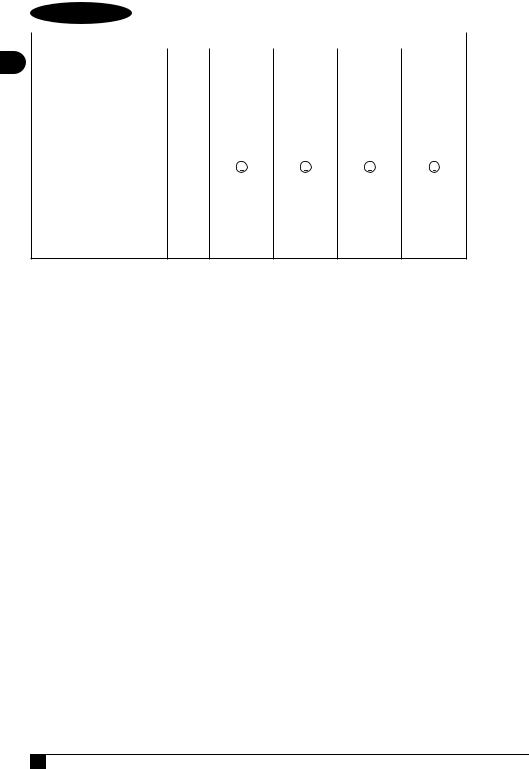
|
ENGLISH |
(Original instructions) |
|
|
|
|
|
|
|
|
|
|
|
|
|||||
|
|
|
|
|
|
|
|
|
|
|
|
|
|
|
|
|
|
|
|
|
Technical Data |
Unit |
BXUP250PCE |
BXUP750PTE |
BXUP750XCE |
BXUP1100XDE |
|||||||||||||
EN |
Voltage |
V/Hz |
230 V ~ 50 Hz |
230 V ~ 50 Hz |
230 V ~ 50 Hz |
230 V ~ 50 Hz |
|||||||||||||
Power |
W |
250 |
750 |
750 |
1100 |
||||||||||||||
|
|||||||||||||||||||
|
Max. head (Hmax) |
m |
6 |
|
|
8 |
|
|
8.5 |
10.5 |
|||||||||
|
Max. flow rate (Qmax) |
l/h |
6000 |
13000 |
11000 |
16500 |
|||||||||||||
|
Max. water temperature (Tmax) |
°C |
35 |
35 |
35 |
35 |
|||||||||||||
|
Max. immersion depth |
m |
7 |
|
|
7 |
|
|
7 |
|
|
7 |
|
|
|||||
|
Residual water level |
mm |
5 |
|
|
5 / 32 |
14 |
45 |
|||||||||||
|
Max. particle size |
Ø mm |
5 |
|
|
5 / 30 |
5 |
|
|
35 |
|||||||||
|
Protection class |
- |
|
|
|
|
|
|
|
|
|
|
|
|
|
|
|
|
|
|
|
|
|
|
|
|
|
|
|
|
|
|
|
|
|
|
|||
|
|
|
|
|
|
|
|
|
|
|
|
|
|
|
|
|
|||
|
|
|
|
|
|
|
|
|
|
|
|
|
|
|
|
|
|
|
|
|
Motor insulation |
- |
Class F |
Class F |
Class F |
Class F |
|||||||||||||
|
Motor protection |
- |
IPX8 |
IPX8 |
IPX8 |
IPX8 |
|||||||||||||
|
Net weight |
kg |
3.7 |
5.2 |
5.0 |
6.6 |
|||||||||||||
|
Gross weight |
kg |
4.4 |
5.8 |
5.6 |
7.2 |
|||||||||||||
|
Fitting diameter |
mm |
25.4 – 31.75 – 38.1 |
25.4 – 31.75 – 38.1 |
25.4 – 31.75 |
25.4 – 31.75 – 38.1 |
|||||||||||||
|
Cable length |
m |
10 |
10 |
10 |
10 |
|||||||||||||
Subject to technical modification!
12
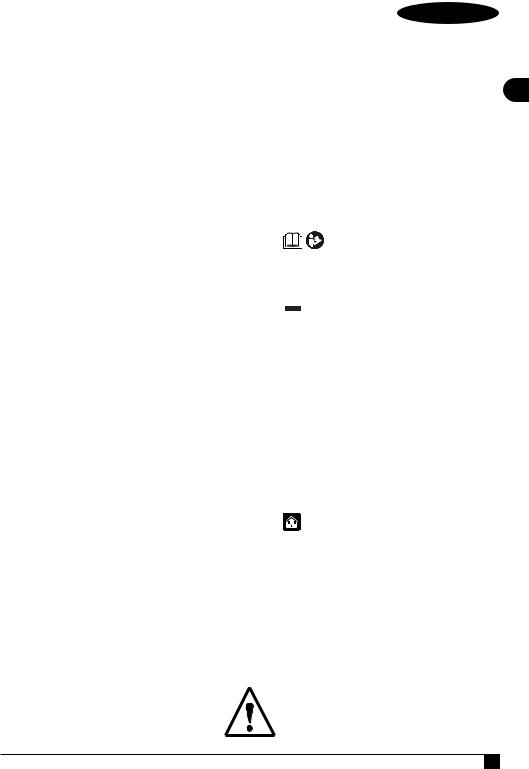
1 ISTRUZIONI PER LA SICUREZZA
1.1 L’apparecchio che avete acquistato è prodotto da un costruttore leader a livello europeo di pompe per uso
domestico |
e |
pompe |
da giardino. |
|
I nostri |
apparecchi |
non |
sono |
|
adatti per |
le |
sollecitazioni |
tipiche |
|
dell’uso commerciale o industriale e per il funzionamento continuo. L'utilizzo ottimale dell'apparecchio presuppone la conoscenza e il rispetto delle istruzioni contenute in questo manuale. In fase di allacciamento, uso e manutenzione dell'apparecchio adottare tutte le precauzioni possibili per salvaguardare la propria sicurezza e quella delle persone nelle immediate vicinanze. Leggere con attenzione e rispettare strettamente le istruzioni di sicurezza poiché, se trascurate, possono mettere a rischio la salute e la sicurezza delle persone o provocare danni economici. Il produttore non è responsabile di eventuali danni causati da utilizzo errato o uso improprio.
(Istruzioni originali) |
ITALIANO |
2 ADESIVI DI SICUREZZA / ADESIVI INFORMATIVI
2.1Attenersi alle etichette applicate IT sull’apparecchio. Verificare che siano sempre presenti e leggibili; in caso contrario sostituirle applicandone di nuove nella posizione originale.
 Attenzione - Pericolo
Attenzione - Pericolo
Leggere attentamente queste istruzioni prima dell’uso.
 Icona E1. Vieta lo smaltimento dell'apparecchio come rifiuto domestico; può essere riconsegnato al distributore all'atto dell'acquisto di un apparecchio nuovo. Le parti elettriche ed elettroniche costituenti l'apparecchio non devono essere riutilizzate per usi impropri a causa della presenza di sostanze dannose
Icona E1. Vieta lo smaltimento dell'apparecchio come rifiuto domestico; può essere riconsegnato al distributore all'atto dell'acquisto di un apparecchio nuovo. Le parti elettriche ed elettroniche costituenti l'apparecchio non devono essere riutilizzate per usi impropri a causa della presenza di sostanze dannose
alla salute.
IconaE3.Indica che l'apparecchio è destinato all'uso domestico.
13
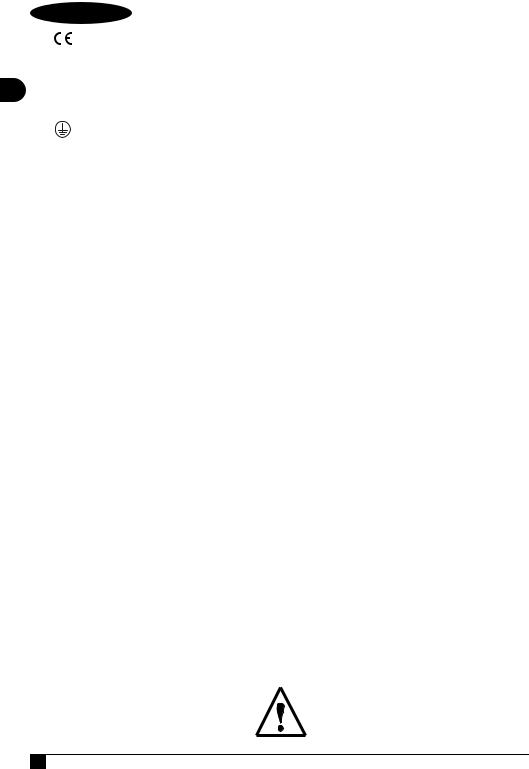
ITALIANO |
(Istruzioni originali) |
IT
Simbolo CE. Indica che l'apparecchio è conforme alle
direttive UE vigenti.
Questo prodotto è in classe di isolamento I. Ciò significa che è equipaggiato di un conduttore di protezione di messa a terra (solo se il
simbolo appare sull’apparecchio).
14
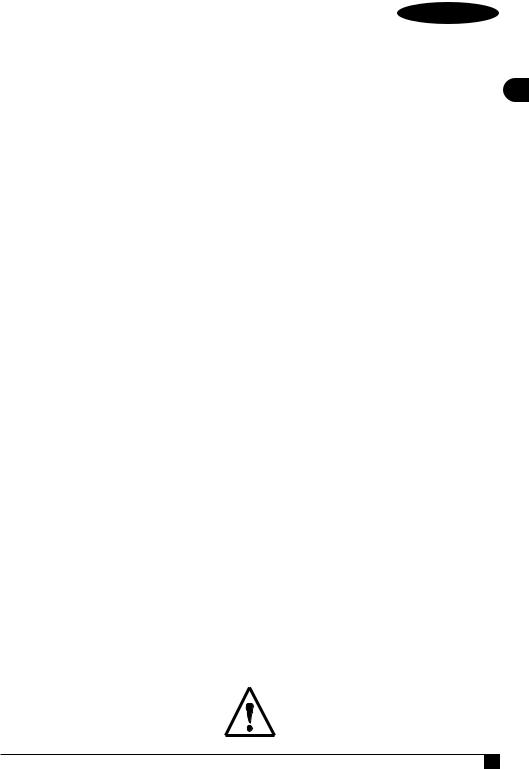
(Istruzioni originali) |
ITALIANO |
3 PRESCRIZIONI DI SICUREZZA / RISCHI RESIDUI
3.1AVVERTENZE: NON FARE
3.1.1 Pericolo di lesioni! L’apparecchio NON può essere utilizzato da bambini e da persone con ridotte capacità fisiche, sensoriali o mentali, o prive di esperienza o della necessaria conoscenza I bambini IT non devono giocare con l’apparecchio. La pulizia e la manutenzione destinata ad essere effettuata dall’utilizzatore non deve essere effettuata da bambini.
3.1.2Pericolo di esplosione o di avvelenamento! Non utilizzare in alcun caso l'apparecchio con liquidi infiammabili,tossicioaggressivioconliquidichepossanocomprometterneilcorrettofunzionamento.
3.1.3Pericolo di lesioni! Non dirigere il getto dell’acqua contro persone o animali.
3.1.4Pericolo di folgorazione! Non dirigere il getto d'acqua sull'apparecchio, su parti elettriche o su altri apparecchi elettrici.
3.1.5Pericolo di corto circuito! Non utilizzare l'apparecchio all'aperto in caso di pioggia. Ciò non vale per le pompe sommergibili, che possono essere utilizzate anche in caso di pioggia; occorre tuttavia garantire che la spina (A12) ed eventuali prolunghe dell'apparecchio siano collegate al riparo dagli spruzzi d'acqua e dagli allagamenti.
3.1.6Pericolo di lesioni! Non consentire l’utilizzo dell'apparecchio da parte di bambini o di persone con limitate capacità sensoriali, fisiche o mentali o comunque non autorizzate.
3.1.7Pericolo di folgorazione! Non toccare la spina (A12) o la presa con le mani bagnate.
3.1.8Pericolo di folgorazione e cortocircuito! Se il cavo elettrico (A8) è danneggiato, esso deve essere sostituito dal costruttore o dal suo servizio assistenza tecnica o comunque da una persona con qualifica similare, in modo da prevenire ogni rischio.
3.1.9Pericolo di scoppio! Non utilizzare l’apparecchio con tubo di aspirazione o di mandata danneggiato.
3.1.10Pericolo di lesioni! Collocare l'apparecchio stabilmente; in caso di utilizzo dell’apparecchio vicino a piscine, stagni da giardino o altri bacini d'acqua aperti, mantenere una distanza minima di 2 m e proteggere l'apparecchio contro la caduta in acqua o l’allagamento. Ciò non vale per le pompe sommergibili, poiché queste possono essere utilizzate immerse in acqua.
3.1.11Pericolo di lesioni! Controllare che l’apparecchio sia provvisto della targhetta recante le caratteristiche specifiche, in caso contrario avvertire immediatamente il rivenditore. Gli apparecchi sprovvisti di targhetta caratteristiche non devono essere usati, essendo anonimi e potenzialmente pericolosi.
15
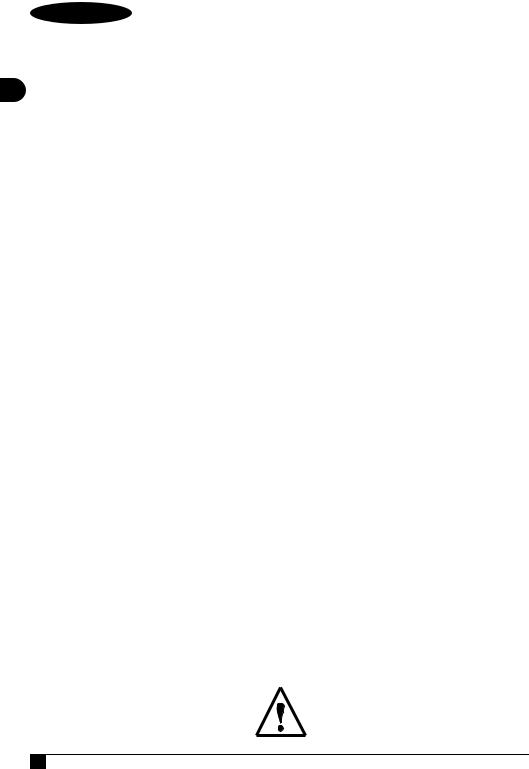
ITALIANO (Istruzioni originali)
3.1.12 Pericolo di scoppio! Non è consentito intervenire su valvole di comando, valvole di sicurezza o altri
|
dispositivi di sicurezza, né modificarne le regolazioni. |
IT |
3.1.13 Pericolo causato da acqua calda! In caso di pressostato difettoso o assenza di alimentazione |
|
idrica, l’acqua ancora presente nel corpo pompa (A4) può surriscaldarsi e causare lesioni alla sua |
|
fuoriuscita. |
3.1.14 Pericolo di lesioni! Non utilizzare l'apparecchio senza sorveglianza se sussiste il pericolo che corpi estranei possano ostruirlo.
3.1.15 Pericolo di corto circuito! Non trasportare l'apparecchio tirando la spina (A12), il cavo elettrico (A8) o altri elementi di allacciamento; utilizzare la maniglia (A4 b).
3.1.16 Pericolo di scoppio! Evitare il passaggio di veicoli sul tubo di aspirazione o di mandata. Non tirare o trasportare l'apparecchio mediante il tubo di aspirazione o di mandata.
3.1.17 Pericolo di lesioni! Non utilizzare l’apparecchio quando persone o animali sostano nel liquido pompato o possono entrare in contatto con esso.
3.2AVVERTENZE: FARE
3.2.1Pericolo di corto circuito! Tutte le parti conduttrici di corrente devono essere protette contro gli spruzzi d’acqua.
3.2.2Pericolo di folgorazione! Allacciare l’apparecchio esclusivamente a una sorgente di elettricità idonea e conforme alle normative vigenti (IEC 60364-1); durante la fase di avviamento l’apparecchio può generare disturbi in rete. Collegare l'apparecchio solo a una presa provvista di interruttore differenziale con corrente residua nominale non superiore a 30 mA. Utilizzare esclusivamente prolunghe conformi alle normative vigenti, approvate per l'impiego all'aperto e con una sezione pari almeno a quella del cavo di alimentazione dell’apparecchio. I cavi elettrici avvolti in avvolgicavo devono essere completamente srotolati.
3.2.3Pericolo! L’apparecchio non deve mai funzionare a secco; prima di accenderla riempire sempre con acqua il corpo pompa (A4). Anche un breve periodo di funzionamento senza acqua può causare danni.
3.2.4Pericolo di accensione non intenzionale! Prima di qualsiasi intervento sull'apparecchio estrarre la spina (A12) dalla presa di corrente.
3.2.5Pericolo! Per garantire la sicurezza dell’apparecchio, la temperatura massima del liquido pompato non deve superare i 35°C. La temperatura ambientale non deve scendere al di sotto di +5°C.
3.2.6Pericolo! L'apparecchio non è destinato al pompaggio di acqua potabile o acqua per consumo umano. L’acqua trasportata dall’apparecchio può essere contaminata da perdite di lubrificante.
16

(Istruzioni originali) |
ITALIANO |
3.2.7 Pericolo di lesioni! La manutenzione e/o la riparazione dell’apparecchio o dei componenti devono essere effettuate solo da personale specializzato.
3.2.8 Pericolo di lesioni! Scaricare la pressione residua prima di staccare il tubo dall’apparecchio; a tale IT scopo scollegare l'apparecchio dall'alimentazione elettrica e aprire un’utenza.
3.2.9Pericolo di lesioni! Prima dell'uso e a intervalli regolari controllare gli accessori e verificare che i componenti dell'apparecchio non presentino segni di rottura e/o usura.
17

ITALIANO |
(Istruzioni originali) |
4 INFORMAZIONI GENERALI
4.1Uso del manuale
Il presente manuale è parte integrante dell'apparecchio; conservare con cura per future consultazioni. Leggere attentamente il manuale
IT |
prima dell’installazione/uso. In caso di passaggi di proprietà il |
|
cedente ha l’obbligo di consegnare il manuale al nuovo proprietario. |
||
|
||
|
Accertarsi che ogni utilizzatore disponga del manuale prima della |
|
|
messa in funzione dell'apparecchio e possa informarsi sulle istruzioni |
|
|
di sicurezza e per l’uso. |
4.2Consegna
L’apparecchio è consegnato all’interno di un imballo di cartone.
Per la composizione della fornitura vedere fig. 1.
4.2.1Materiale informativo in dotazione D1 Manuale di uso e manutenzione D2 Istruzioni per la sicurezza
D3 Regole garanzia
4.3Smaltimento degli imballi
I materiali costituenti l’imballo non sono inquinanti per l’ambiente, tuttavia devono essere riciclati o smaltiti secondo la normativa vigente nel paese di utilizzo.
5 INFORMAZIONI TECNICHE
5.1Uso previsto
Questi apparecchi sono adatti al pompaggio di acqua pulita o sporca contenente corpi solidi in sospensione con una grandezza massima fino a 35 mm (p.es. svuotamento in caso di allagamento o impiego in bacini di raccolta di acqua piovana). Tenere presente la rispettiva granulometria del tipo apparecchio utilizzato; granulometria e ulteriori dati tecnici sono riportati nella scheda tecnica del presente manuale. Gli apparecchi con una granulometria fino a 5 mm sono adatti per acqua pulita, quelli a partire da 25 mm sono indicati per acqua sporca. L'indicazione di una granulometria e/o di corpi solidi non si riferisce a sabbia o sassi! Si riferisce a elementi teneri e flessibili (p.es. lanugine o foglie) che non si incastrano all'interno del corpo pompa (A4) e che pertanto non bloccano la girante, causando di conseguenza guasti al motore. Se non è possibile accertare che il liquido pompato non contenga sabbia o sassi, l’apparecchio deve essere azionato solo dietro supervisione. In caso di blocco della girante, l’apparecchio deve essere spenta immediatamente e la girante deve essere liberata da ostruzioni risciacquandola con acqua pulita.
L’apparecchio è conforme alla norma europea EN 60335-2-41.
5.2Uso non consentito
Èvietato l'uso a persone inesperte o che non abbiano letto e compreso le istruzioni riportate nel manuale.
Èvietato alimentare l’apparecchio con liquidi infiammabili, esplosivi, tossici o chimicamente aggressivi.
Èvietato utilizzare l'apparecchio in atmosfera potenzialmente infiammabile o esplosiva.
Èvietato eseguire modifiche all'apparecchio; l’esecuzione di modifiche fa decadere la garanzia ed esonera il produttore da responsabilità civili e penali.
Sostanze smeriglianti o altre sostanze che attaccano i materiali distruggono l’apparecchio. Questi apparecchi non sono adatti per l'impiego in liquidi pompati contenenti sabbia, fango o argilla abrasivi. Questi apparecchi sono adatti per il pompaggio di acqua per i servizi, mentre non sono idonei per il pompaggio di acqua potabile!
Con questi apparecchi non è consentito trasportare sostanze fecali. Gli apparecchi non sono adatti per essere utilizzati come pompe per fontane, pompe di filtraggio per stagni da giardino o per il funzionamento continuo (p.es. in modalità a ricircolo continuo negli impianti di filtraggio di piscine o per un impiego industriale).
Evitare il funzionamento secco dell’apparecchio o il pompaggio di liquidi con una valvola chiusa!
5.3Parti principali (fig. 1)
A1 Griglia di aspirazione
A2 Raccordo di mandata
A3 Manicotto di mandata
A4 Corpo pompa A4b Maniglia
A5 Interruttore a galleggiante
A5b Clip cavo per interruttore a galleggiante A6 Piedi pieghevoli (dove previsti)
A7 Foro di sfiato
A8 Cavo elettrico
6 INSTALLAZIONE
 Attenzione - pericolo!
Attenzione - pericolo!
Tutte le operazioni d’installazione e montaggio devono essere effettuate con l’apparecchio scollegato dalla rete elettrica (fig. 3).
 Attenzione - pericolo!
Attenzione - pericolo!
Prima dell'utilizzo effettuare sempre un controllo a vista per determinare se l'apparecchio, e in particolare spina (A12) e cavo elettrico (A8), sono danneggiati. Un apparecchio danneggiato non deve essere utilizzato; in caso di danni fare controllare l'apparecchio dal Centro Assistenza o da un elettricista autorizzato.
 Attenzione - pericolo!
Attenzione - pericolo!
Tagliare il cavo elettrico (A8) comporta il decadimento della garanzia e l’installazione a pagamento, durante la riparazione (anche in caso di riparazioni in garanzia), di un cavo elettrico (A8) originale. Se il cavo elettrico (A8) deve essere allungato, utilizzare esclusivamente una prolunga la cui sezione sia almeno uguale a quella del cavo elettrico (A8) originale. Non sollevare mai l’apparecchio o estrarre la spina (A12) dalla presa usando il cavo elettrico (A8).
6.1Montaggio del tubo di mandata
Prima di montare il tubo di scarico, tagliare a formato il manicotto di mandata (A3) in modo da garantire il flusso massimo possibile in combinazione con il tubo utilizzato (fig. 4).
L'ideale è un diametro del tubo che superi la granulometria dell’apparecchio. Diametri dei tubi inferiori riducono drasticamente la portata. Avvitare il manicotto sul corpo pompa (A4), quindi collegare il tubo di mandata al manicotto di mandata (A3, fig. 4).
6.2Sfiato dell’apparecchio
Immergere l’apparecchio obliquamente nel liquido pompato affinché tutta l'aria possa fuoriuscire dal corpo (fig. 5). Tenere l’apparecchio in
posizione obliqua finché non fuoriescono più bolle d'aria; l’apparecchio è quindi pronto per funzionare.
Fra il lato superiore e quello inferiore degli apparecchi in plastica è presente un foro di sfiato (A7) che permette la lenta fuoriuscita dell’aria. Quando è uscita tutta l’aria, da questo foro fuoriesce acqua; questo non è un errore ma è tecnicamente necessario. La portata indicata nei dati tecnici considera già questa perdita!
Negli apparecchi in acciaio inox questo foro di sfiato (A7) si trova nella parte superiore dell’apparecchio.
18
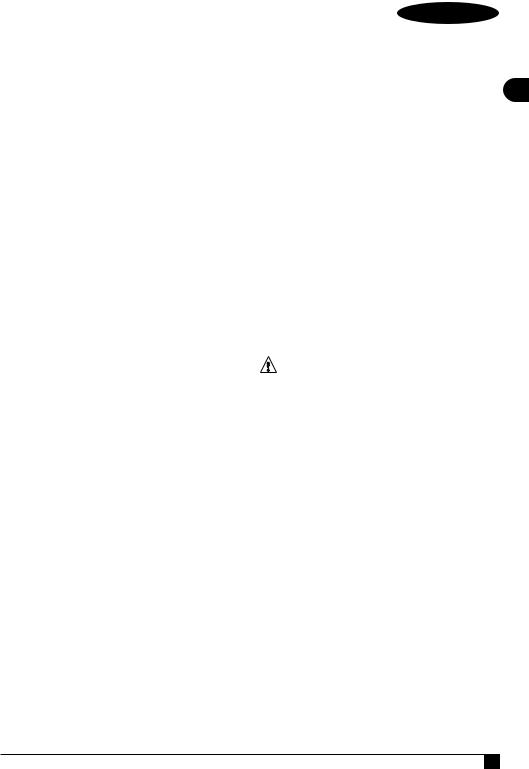
6.3Note sul luogo di installazione
Prima di posizionare l’apparecchio è necessario fissare alla maniglia (A4 b) una fune di recupero in modo da calare/recuperare il medesimo in maniera adeguata (fig.6).
L‘apparecchio dovrebbe possibilmente essere sospeso nel liquido pompato ad una distanza sufficiente dal fondo, per evitare l'aspirazione di sostanze solide di dimensioni inadeguate e di conseguenza la possibile ostruzione della griglia di aspirazione (A1) o il blocco della girante (fig. 6). In alternativa l’apparecchio può anche essere
leggermente rialzato da terra (p.es. collocata su mattone, fig. 6); in tal caso però verrà aspirata una maggiore quantità di particelle di sporco che possono eventualmente ostruire l’apparecchio.
Dopo lo spegnimento dell’apparecchio l'acqua presente nel tubo fluisce in senso inverso; ciò può essere impedito mediante l'installazione di una valvola di ritegno. L’installazione di una chiusura rapida per una separazione del tubo in un punto adatto agevola i lavori di pulizia e manutenzione. Se l’apparecchio viene utilizzato in un pozzetto fognario o in un pozzo per le pompe, la grandezza del bacino di raccolta deve essere sufficientemente ampio da non ostacolare il normale funzionamento dell’apparecchio.
L'interruttore a galleggiante (A5) dell’apparecchio non deve essere bloccato od ostacolato nel galleggiamento, poiché altrimenti non è possibile garantire un funzionamento regolare. Se non si è certi che l'interruttore a galleggiante (A5) possa attivarsi e disattivarsi regolarmente, l’apparecchio deve essere azionata solo sotto supervisione.
6.4Misure di sicurezza
L’operatore deve escludere danni conseguenti a un allagamento di ambienti o altro in caso di guasti dell’apparecchio o di componenti esterni adottando misure adeguate (p.es. installazione di una protezione contro gli allagamenti, impianto d'allarme, pompa di riserva, vasca di raccolta e simili), da collegare a un circuito elettrico
separato e a prova di guasto. Le misure di sicurezza devono essere adeguate alle singole situazioni di utilizzo ed essere in grado di ridurre e/o impedire i danni causati dalla fuoriuscita di acqua.
Inoltre, tramite una protezione contro gli spruzzi, l'utilizzatore deve provvedere affinché l'acqua fuoriuscita o spruzzata a seguito di un guasto, non arrechi danni. È necessario garantire che l'acqua fuoriuscita venga rimossa tramite una pompa di riserva o defluisca attraverso uno scarico. In alternativa può essere installato un impianto d'allarme che, in caso di fuoriuscita d’acqua, emetta un allarme e/o determini un arresto di emergenza dell’apparecchio e dell'alimentazione idrica prima che apparecchiature o immobili vengano danneggiati.
Negli ambienti dove vengono installati gli apparecchi raccomandiamo inoltre di rialzare tutte le apparecchiature di ca. 5 – 10 cm affinché l'acqua fuoriuscita non possa causare danni immediati. I danni causati dal mancato rispetto di queste prescrizioni non potranno essere rivendicati presso il produttore.
 Attenzione - pericolo! Funzionamento a secco
Attenzione - pericolo! Funzionamento a secco
Se l’apparecchio funziona per più di 5 minuti con il punto di prelievo dell'acqua chiuso, può subire danni a causa del surriscaldamento. Spegnere l’apparecchio quando il normale flusso dell’acqua è impedito.
Il funzionamento a secco distrugge l’apparecchio, quindi non fare mai funzionare l’apparecchio a secco per più di 10 secondi.
(Istruzioni originali) |
ITALIANO |
7 REGOLAZIONI
7.1Regolazioni preliminari
L’apparecchio è pronto per funzionare ed è necessario solo regolare i punti di attivazione e disattivazione dell'interruttore a galleggiante (A5)
|
in base al proprio caso applicativo. |
IT |
|
7.2 |
Regolazione dell'interruttore a galleggiante |
||
|
|||
|
Il punto di attivazione dell’apparecchio può essere regolato |
|
|
|
accorciando il cavo dell'interruttore a galleggiante nella relativa clip |
|
|
|
(A5 b, fig. 7). Un cavo corto determina un punto di attivazione più |
|
|
|
tardivo e un disinserimento anticipato. |
|
|
7.3 |
Funzioni speciali |
|
|
|
7.3.1 Base variabile per acque chiare o di scarico |
|
Nei modelli multifunzione è possibile chiudere i piedi della base dell’apparecchio (A6), commutando così l’apparecchio dalla modalità di utilizzo per acque di scarico a quella per acque chiare. In questo caso l’apparecchio aspira acqua fino a una quantità residua di 5 mm, può trattare però solo sostanze in sospensione con granulometria fino a max. 5 mm (fig. 8).
7.3.2 Arresto dell'interruttore a galleggiante (A5)
In alcuni modelli è possibile bloccare in posizione verticale l’interruttore a galleggiante (A5) in un supporto (A5 b, fig. 10). Quando l’interruttore a galleggiante è bloccato, l’apparecchio funziona in continuo indipendentemente dal livello dell’acqua e deve essere azionata solo sotto supervisione per evitare un funzionamento a secco.
8 MESSA IN FUNZIONE E PROCESSO DI ASPIRAZIONE
Attenzione - pericolo!
Tutte le operazioni d’installazione e montaggio devono essere effettuate con l’apparecchio scollegato dalla rete elettrica (fig. 3).
8.1Messa in funzione
Dopo che l’apparecchio è stato collegato come descritto nel paragrafo 6 e tutte le istruzioni per la sicurezza sono state considerate, è possibile inserire la spina (A12). L’apparecchio si attiva quindi automaticamente quando il livello dell'acqua raggiunge l'altezza impostata dell'interruttore a galleggiante e si spegne nuovamente al raggiungimento del livello di disattivazione.
8.2Aspirazione dell'acqua
Per l'aspirazione / l’avviamento l’apparecchio necessita di un livello dell'acqua superiore di circa 30 – 50 mm rispetto alla quantità aspirata minima. Dopo che l’apparecchio ha iniziato ad aspirare, è poi in grado pompare fino all'altezza minima indicata. L’apparecchio aspira l’acqua dalla griglia di aspirazione (A1) alla sua base e la trasporta tramite un tubo di mandata collegato al manicotto di mandata (A3).
Se nonostante un livello dell'acqua sufficiente e il motore in funzione l’acqua non viene aspirata è possibile che sia presente aria residua nel corpo pompa (A4). Procedere come descritto al punto 6.2 e sfiatare nuovamente l’apparecchio.
8.3Aspirazione dell'acqua
I valori di portata dell’apparecchio indicati sono valori massimi, che si riducono utilizzando componenti esterni (p.es. tubo di mandata, angolari, riduzioni ecc.). Si prega di tenere presente questo aspetto nella scelta dell’apparecchio. La portata effettiva per gli specifici casi applicativi è indicata nel diagramma di portata (fig. 10).
19

|
ITALIANO |
(Istruzioni originali) |
|
9 MANUTENZIONE |
|
|
Attenzione - pericolo! |
|
|
Prima di ogni intervento di manutenzione e/o durante la ricerca guasti |
|
IT |
scollegare il cavo elettrico (A8) dalla presa. In seguito sarà possibile effettuare |
|
tutti i lavori di manutenzione e pulizia. |
|
|
9.1Pulizia
Dopo ogni utilizzo risciacquare l’apparecchio e tutti i componenti esterni con acqua pulita. Rimuovere le incrostazioni con un getto d’acqua. Sporco e argilla all'interno del corpo pompa (A4) causano un inceppamento della girante e di conseguenza anomalie di funzionamento alla rimessa in funzione.
Qualora si sia dimenticato di eseguire queste operazioni, è possibile immergere l’apparecchio per diversi giorni in acqua con una temperatura massima di 35°C per disciogliere lo sporco.
9.2Controllo del funzionamento
Controllare regolarmente il funzionamento dell'interruttore a galleggiante (A5) per prevenire inconvenienti.
10 STOCCAGGIO
L’apparecchio deve assolutamente essere protetto dal gelo e, in caso di temperature di +5°C o inferiori, deve essere smontato e immagazzinato in un ambiente asciutto e al riparo dal gelo.
20

|
|
|
(Istruzioni originali) |
ITALIANO |
||
11 RICERCA GUASTI |
|
|
|
|
|
|
|
|
|
|
|
|
|
Guasto |
|
Possibile causa |
|
Rimedio |
|
|
|
|
|
|
|
|
|
|
1. |
Tensione di rete insufficiente. |
1. |
Controllare se è presente tensione di rete e se la spina (A12) è |
|
|
|
completamente inserita. |
|
|
|||
|
|
|
|
IT |
||
L’apparecchio non trasporta acqua |
2. |
Spina (A12) inserita in modo errato. |
2. |
Inserire completamente la spina (A12). |
|
|
|
|
3. Attivare l'interruttore magnetotermico differenziale. |
|
|||
perché il motore non funziona |
3. Interruttore magnetotermico differenziale intervenuto. |
|
||||
Se l'interruttore interviene di nuovo, consultare un elettricista. |
|
|||||
|
|
|
|
|||
|
4. |
Girante bloccata. |
4. |
Liberare la girante da possibili impedimenti. |
|
|
|
5. |
Danneggiamento del motore o del condensatore. |
5. |
Informare il rivenditore. |
|
|
L’apparecchio non trasporta acqua |
1. |
Griglia di aspirazione (A1) ostruita. |
1. |
Pulire la griglia di aspirazione (A1). |
|
|
2. Valvola di ritegno bloccata (se presente). |
2. |
Pulire o sostituire la valvola (se presente) |
|
|||
sebbene il motore funzioni |
3. |
Bolla d'aria nel corpo pompa (A4). |
3. |
Tenere obliquo l’apparecchio sott'acqua affinché l'aria possa |
|
|
|
fuoriuscire dal corpo pompa (A4). |
|
|
|||
|
|
|
|
|
||
L’apparecchio eroga solo una |
1. |
Griglia di aspirazione (A1) parzialmente sporca. |
1. |
Pulire la griglia di aspirazione (A1). |
|
|
2. Tubo ostruito. |
2. |
Eliminare l’ostruzione. |
|
|
||
quantità d'acqua limitata |
3. Tubo di mandata di dimensioni insufficienti. |
3. |
Utilizzare tubi flessibili di almeno ø25 mm (1”). |
|
||
|
4. |
Punto di uscita dell’acqua troppo alto rispetto all’apparecchio. |
4. |
Tenere presente che la prevalenza va a discapito della portata. |
|
|
|
1. |
Corpi solidi bloccano la libera rotazione della girante. |
1. |
Rimuovere i corpi estranei. |
|
|
|
2. |
Temperatura del liquido eccessiva. |
2. |
La temperatura massima del liquido trasportato non deve |
|
|
Funzionamento irregolare |
superare i 35°C. |
|
|
|||
|
|
|
|
|||
3. |
Tensione elettrica al di fuori della tolleranza. |
3. |
Collegare l’apparecchio ad un impianto elettrico che soddisfa i |
|
||
|
|
|||||
|
requisiti indicati nell’etichetta |
|
|
|||
|
|
|
|
|
||
|
4. |
Motore difettoso. |
4. |
Informare il rivenditore. |
|
|
Fuoriuscita d'acqua dal corpo |
1. L'acqua fuoriesce dal foro di sfiato (A7) tra la parte superiore |
1. |
Non occorre alcun intervento, il foro di sfiato è tecnicamente |
|
||
pompa (A4) |
e quella inferiore. |
necessario |
|
|
||
GARANZIA
Le garanzie relative agli apparecchi descritti nel presente manuale presuppongono l'osservanza e il rispetto di tutte le indicazioni in esso contenute, in particolare quelle relative all'impiego, all'installazione e all’esercizio.
Per il prodotto descritto concediamo una garanzia di 24 mesi (12 mesi per la vendita professionale), a partire dalla data di acquisto, per difetti dei materiali o di produzione in conformità alle leggi vigenti. È possibile inoltrare richieste di garanzia solo dietro presentazione della prova di acquisto originale.
La garanzia non copre i costi di smontaggio e montaggio dell'apparecchio contestato nel luogo di impiego, i costi di trasferta del personale addetto alla riparazione verso e dal luogo di impiego, nonché i costi di trasporto.
I reclami le cui cause sono da ricondurre a errori di installazione o di azionamento, condizioni di impiego inadeguate, cura insufficiente, impiego commerciale o tentativi di riparazione non appropriati sono esclusi dalla garanzia e dalla responsabilità, così come la normale usura.
I costi che ne derivano, in particolare le spese di verifica e di trasporto, sono a carico del mittente e/o gestore dell’apparecchio. Ciò vale in particolare anche quando viene inoltrata una richiesta di garanzia, ma dal controllo risulta che l'apparecchio funziona perfettamente ed è esente da difetti o che il problema non è riconducibile a difetti dei materiali o di produzione.
Prima della riconsegna ogni prodotto è sottoposto a un severo controllo tecnico. Le riparazioni in garanzia devono essere effettuate solo dal nostro
CentroAssistenzaodaun'officinaconvenzionataautorizzata.Tentatividiriparazionedapartedelclienteoditerzinonautorizzatiduranteilperiododigaranzia determinano il decadimento del diritto di garanzia.
Tagliare la spina di rete e/o accorciare il cavo di rete determinano il decadimento della garanzia.
Gli interventi in garanzia da noi resi non prolungano la durata della garanzia, né motivano un nuovo periodo di garanzia per le parti sostituite o riparate. Sono esclusi ulteriori diritti, in particolare quelli di sconto, cambiamento o risarcimento danni, ma anche per danni conseguenti di qualsiasi tipo.
In caso di guasto rivolgersi al punto vendita dove si è acquistato il prodotto unitamente alla prova di acquisto.
21
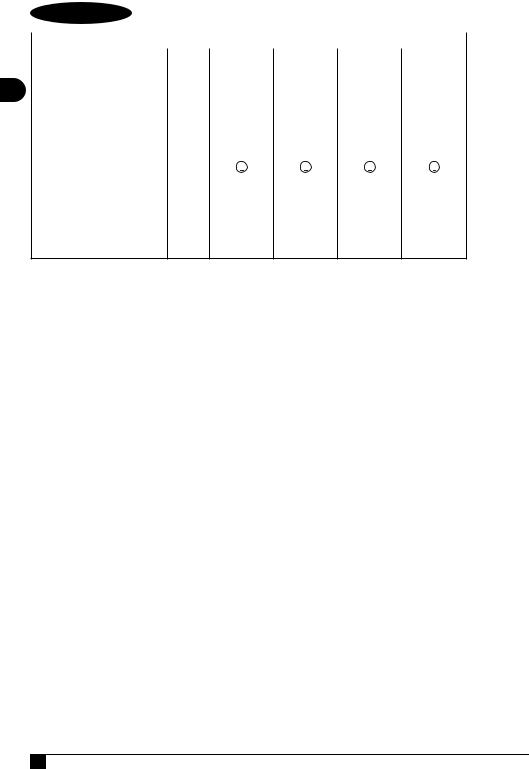
|
ITALIANO |
(Istruzioni originali) |
|
|
|
|
|
|
|
|
|
|
|
|
|||||
|
|
|
|
|
|
|
|
|
|
|
|
|
|
|
|
|
|
|
|
|
Dati tecnici |
Unità |
BXUP250PCE |
BXUP750PTE |
BXUP750XCE |
BXUP1100XDE |
|||||||||||||
|
Tensione |
V/Hz |
230 V ~ 50 Hz |
230 V ~ 50 Hz |
230 V ~ 50 Hz |
230 V ~ 50 Hz |
|||||||||||||
|
Potenza |
W |
250 |
750 |
750 |
1100 |
|||||||||||||
IT |
Prevalenza max. (Hmax) |
m |
6 |
|
|
8 |
|
|
8.5 |
10.5 |
|||||||||
Portata max. (Qmax) |
l/h |
6000 |
13000 |
11000 |
16500 |
||||||||||||||
|
|||||||||||||||||||
|
Temperatura acqua max. (Tmax) |
°C |
35 |
35 |
35 |
35 |
|||||||||||||
|
Profondità di immersione max. |
m |
7 |
|
|
7 |
|
|
7 |
|
|
7 |
|
|
|||||
|
Livello acqua residua |
mm |
5 |
|
|
5 / 32 |
14 |
45 |
|||||||||||
|
Granulometria max. |
Ø mm |
5 |
|
|
5 / 30 |
5 |
|
|
35 |
|||||||||
|
Classe protezione |
- |
|
|
|
|
|
|
|
|
|
|
|
|
|
|
|
|
|
|
|
|
|
|
|
|
|
|
|
|
|
|
|
|
|
|
|||
|
|
|
|
|
|
|
|
|
|
|
|
|
|
|
|
|
|||
|
|
|
|
|
|
|
|
|
|
|
|
|
|
|
|
|
|
|
|
|
Isolamento motore |
- |
Classe F |
Classe F |
Classe F |
Classe F |
|||||||||||||
|
Protezione motore |
- |
IPX8 |
IPX8 |
IPX8 |
IPX8 |
|||||||||||||
|
Peso netto |
kg |
3.7 |
5.2 |
5.0 |
6.6 |
|||||||||||||
|
Peso lordo |
kg |
4.4 |
5.8 |
5.6 |
7.2 |
|||||||||||||
|
Diametro raccordi |
mm |
25.4 – 31.75 – 38.1 |
25.4 – 31.75 – 38.1 |
25.4 – 31.75 |
25.4 – 31.75 – 38.1 |
|||||||||||||
|
Lunghezza cavo |
m |
10 |
10 |
10 |
10 |
|||||||||||||
Con riserva di modifiche tecniche!
22

(Превод на оригиналните инструкции) |
БЪЛГАРСКИ |
1 УКАЗАНИЯ ЗА БЕЗОПАСНОСТ
1.1Закупеният от Вас уред е произведен от един от водещите в Европа производители на битови и градински помпи. Нашите уреди не са предназначени да издържат натоварванията, типични за
търговска или промишлена употреба или за непрекъсната експлоатация. За да извлечете максимума от Вашата помпа е необходимо да познавате
испазвате инструкциите, представени в това ръководство. По време на свързването, използването и обслужването на уреда вземете всички възможни предпазни мерки, за да осигурите своята собствена безопасност и тази на хората в непосредствена близост. Прочетете внимателно
испазвайте разпоредбите за безопасност; в противен случай можете да изложите на опасност здравето и безопасността си или да причините скъпоструваща повреда. Производителят не носи отговорност за повреди, предизвикани от неправилна употреба.
2 ЕТИКЕТИ ЗА БЕЗОПАСНОСТ/ ИНФОРМАЦИЯ
2.1Спазвайте препоръките върху етикетите, прикрепени към уреда.
Проверете дали те са налични BG и четливи; в противен случай ги заменете с нови, поставени на същите места.
 Предупреждение — Опасност
Предупреждение — Опасност
Прочетете внимателно тези указания преди употреба.
 Символ Е1. Уредът не трябва да се изхвърля като битов отпадък; той може да се предаде на търговския представител при закупуването на нов уред.
Символ Е1. Уредът не трябва да се изхвърля като битов отпадък; той може да се предаде на търговския представител при закупуването на нов уред.
Електрическите |
и електронните |
||
части |
на уреда |
не трябва |
да |
се |
използват |
повторно |
по |
нерегламентиран начин, тъй като съдържат опасни за здравето вещества.
 Символ E3. Показва, че уредът е предназначен за битова
Символ E3. Показва, че уредът е предназначен за битова
употреба.
23
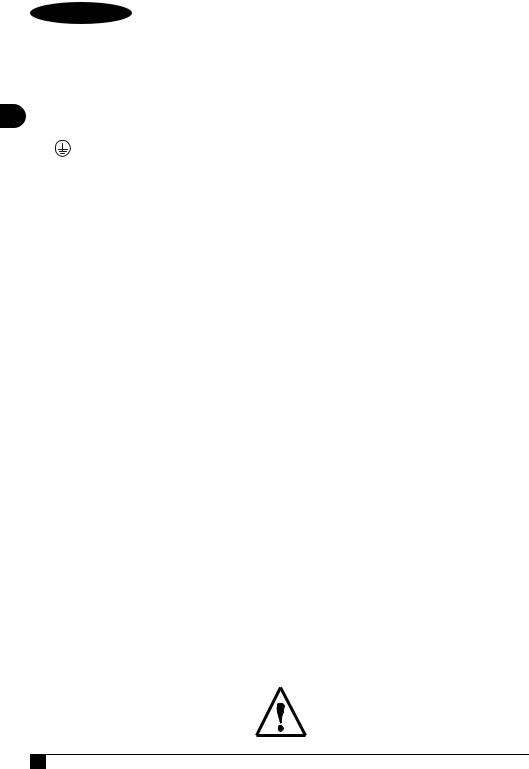
БЪЛГАРСКИ |
(Превод на оригиналните инструкции) |

 Символ СE. Показва, че уредът съответства на изискванията на съответните
Символ СE. Показва, че уредът съответства на изискванията на съответните
директиви на ЕС.
BG
Това изделие е от I изолационен клас.
Това означава, че има защитен заземяващ проводник (само ако символът фигурира върху уреда).
24
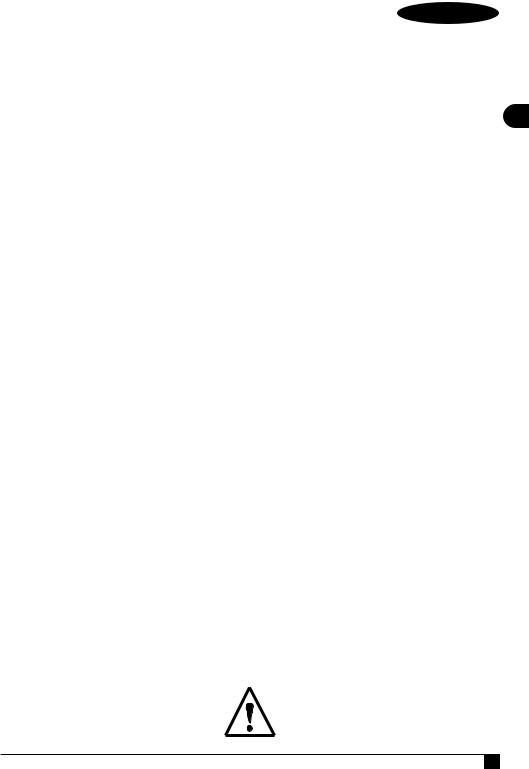
(Превод на оригиналните инструкции) |
БЪЛГАРСКИ |
3 ПРАВИЛА ЗА БЕЗОПАСНОСТ/ОСТАТЪЧНИ РИСКОВЕ
3.1МЕРКИ ЗА БЕЗОПАСНОСТ: НЕ ПРАВЕТЕ ТОВА
3.1.1Опасност от нараняване! НЕ допускайте използване на уреда от деца, лица с намалени физически, сетивни или умствени способности, или лица без необходимия опит и познания.
Не се допуска използване на уреда като играчка от деца. Почистването и потребителската BG поддръжка не трябва да се извършват от деца.
3.1.2Опасност от експлозия или отравяне! Никога не използвайте уреда с възпламеними, отровни или агресивни течности, както и с течности, чийто характеристики са несъвместими с правилната му експлоатация.
3.1.3Опасност от нараняване! Не насочвайте водната струя към хора или животни.
3.1.4Опасност от електрически удар! Не насочвайте водната струя към уреда, електрически части или други електрически устройства.
3.1.5Опасност от късо съединение! Никога не използвайте уреда на открито в дъждовно време. Това не се отнася за потопяеми помпи, които могат да бъдат използвани по време на дъжд; независимо от това е необходимо да се вземат мерки щепселът (А12) и всякакви използвани удължаващи кабели да бъдат защитени от водни пръски или потапяне.
3.1.6Опасност от нараняване! Не допускайте използване на уреда от деца, лица с намалени физически, сетивни или умствени способности или неоторизирани лица.
3.1.7Опасностотелектрическиудар!Не докосвайте щепсела (A12) и/или контакта с мокри ръце.
3.1.8Опасност от електрически удар и късо съединение! Ако електрическият кабел (А8)
е повреден, той трябва да се смени от производителя, някой от упълномощените от него сервизни центрове или друго квалифицирано лице, за избягване на опасности.
3.1.9Опасност от експлозия! Не използвайте уреда, ако смукателният или напорният маркучи са повредени.
3.1.10Опасност от нараняване! Поставете уреда в стабилна позиция; когато използвате уреда в близост до плувни басейни, градински езера или други водни площи на открито, го дръжте на най-малко 2 m от края на водата и не допускайте падане във водата или намокряне. Това не се отнася за потопяемите помпи, тъй като те се използват потопени във вода.
3.1.11Опасностотнараняване!Проверетедалиуредътимаидентификационнатабелка,съдържаща неговите технически характеристики; свържете се с Вашия търговски представител, ако такава липсва. Уреди без идентификационна табелка не трябва да се използват, защото не могат да бъдат идентифицирани и могат да бъдат опасни.
25
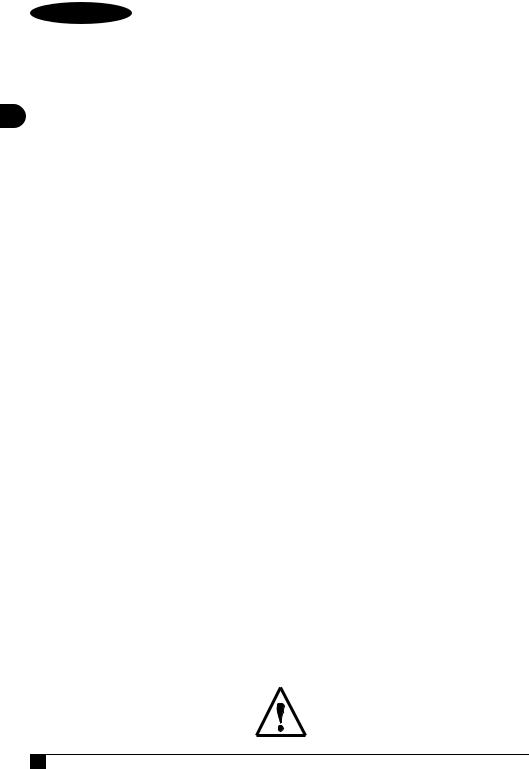
БЪЛГАРСКИ |
(Превод на оригиналните инструкции) |
3.1.12Опасност от експлозия! Не се допуска регулиране на управляващи клапани и вентили за безопасност, както и други устройства за безопасност, или промяна на техните настройки.
3.1.13Опасност от изгаряне! При повреда на превключвателя за налягане или прекъсване на
|
водозахранването, водата, останала във вътрешността на тялото на помпата (А4) може да |
BG |
прегрее и да предизвика изгаряне, когато бъде освободена. |
3.1.14Опасност от нараняване! Не използвайте уреда без надзор, има опасност от авария.
3.1.15Опасностоткъсосъединение!Непремествайтеуредакатогодърпатезащепсела(А12),за захранващите кабели (А8) или за други съединения; използвайте ръкохватката (А4b).
3.1.16Опасностотексплозия!Недопускайтепревознисредствадаминаватпрезсмукателнияили напорния маркуч. Не теглете и не транспортирайте уреда като го теглите за смукателния или напорния маркуч.
3.1.17Опасност от нараняване! Не използвайте уреда, когато хора или домашни любимци са в течността, която се изпомпва или има опасност да влязат в контакт с нея.
3.2МЕРКИ ЗА БЕЗОПАСНОСТ: ЗАДЪЛЖЕНИЯ ЗА БЕЗОПАСНОСТ
3.2.1Опасност откъсо съединение!Всички електрически проводници трябва да бъдат защитени от водни пръски.
3.2.2Опасност от електрически удар! Свързвайте уреда към източник на електрически ток, отговарящ на съответните стандарти (IEC 603641-1); по време на пускане в действие уредът можедапредизвикасмущениявелектрическатасистема.Свързвайтеуредасамокъмконтакти, съоръжени с устройство за защита от късо съединение към земята, с номинална стойност 30 mA или по-малко. Използвайте само електрически проводници, отговарящи на съответните регламенти, одобрени за използване на открито, с напречно сечение най-малко равно на това на захранващия кабел на уреда. Захранващи кабели, навити на макари, трябва да бъдат напълно размотани.
3.2.3Опасност! Уредът никога не трябва да работи на сухо; винаги напълвайте тялото на помпата (А4) с вода преди да я пуснете в действие. Дори и кратък период на работа на помпата без вода може да я повреди.
3.2.4Опасност от неволно включване! Винаги изключвайте щепсела (A12) от контакта, преди да работите по уреда.
3.2.5Опасност! За гарантиране безопасността на уреда, максималната температура на изпомпваната течност не трябва да превишава 35 °C. Температурата на околната среда не трябва да спада под +5 °C.
26
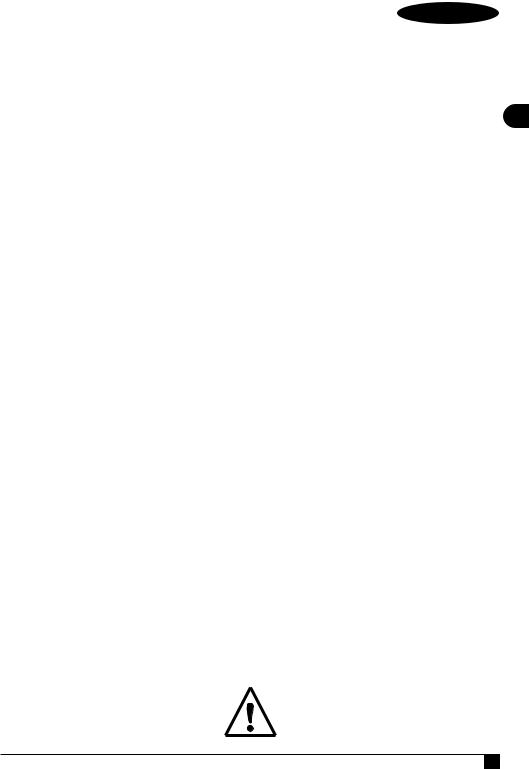
(Превод на оригиналните инструкции) |
БЪЛГАРСКИ |
3.2.6Опасност! Уредът не е предназначен за изпомпване на вода с питейно качество или вода за консумация от хора. Изпомпваната вода може да е замърсена от течове на смазка.
3.2.7Опасност от нараняване! Поддръжката и/или ремонтът на електрическите компоненти на
уреда трябва да се извършват от квалифициран персонал.
3.2.8 Опасностотнараняване!Предиразединяваненамаркучаотуреда,освободетеостатъчното BG налягане; за да направите това, изключете уреда от електрозахранването и отворете изпускателния отвор.
3.2.9Опасност от нараняване! Преди употреба и на редовни интервали проверявайте принадлежностите и компонентите на уреда за признаци за повреда и/или износване.
27

БЪЛГАРСКИ |
(Превод на оригиналните инструкции) |
4 ОБЩА ИНФОРМАЦИЯ |
|
4.1 |
Използване на ръководството |
|
Това ръководство е неделима част от уреда и трябва да се пази |
|
за справки. Прочетете го внимателно преди да монтирате или да |
|
използвате уреда. Ако уредът се продава, продавачът трябва да |
|
предаде това ръководство заедно с уреда на новия собственик. |
BG |
Преди пускане на уреда в експлоатация вземете мерки всеки от |
потребителите да има достъп до ръководството и да се запознае |
|
с мерките за безопасност и инструкциите за работа.
4.2Доставка
Уредът се доставя в картонена кутия.
Окомплектоването на доставката е илюстрирано на фиг. 1.
4.2.1 Информационни материали, предоставяни заедно с
уредаD1 Ръководство за експлоатация и техническо обслужване
D2 Указания за безопасност
D3 Гаранционни условия
4.3Депониране на опаковката
|
Опаковъчните материали не замърсяват околната среда, |
|
но въпреки това трябва да се рециклират или депонират в |
|
съответствие с действащото законодателство на страната, в |
|
която се използва уредът. |
5 ТЕХНИЧЕСКА ИНФОРМАЦИЯ |
|
5.1 |
Предназначение |
|
Тези уреди са подходящи за изпомпване на чиста или замърсена |
|
вода, съдържаща суспендирани твърди частици с големина не |
|
повече от 35 mm (напр. за изпомпване в случаи на наводнения |
|
или от резервоари за дъждовна вода). Отчетете разрешения |
|
размер на частиците за типа на използвания уред; големината |
|
на частиците и допълнителни технически характеристики са |
|
посочени в таблицата с данни за безопасност в това ръководство. |
|
Уреди за частици с размери до 5 mm са подходящи за чиста вода, |
|
а тези за частици с размери от 25 mm и повече са за използване |
|
за замърсена вода. Пясъкът и камъчетата не представляват |
|
допустимичастиции/илитвърдивещества!Разрешенисачастици |
|
от меки, гъвкави материали (напр. влакна или листа), които не |
|
блокират вътрешността на тялото на помпата (А4) и ротора, с |
|
което да повредят мотора. Ако е невъзможно да се гарантира, че |
|
изпомпваната течност не съдържа пясък или камъчета, уредът |
|
не трябва да се оставя да работи без наблюдение. Ако роторът |
|
блокира, уредът трябва незабавно да бъде изключен и роторът |
|
да бъде освободен от задръстването посредством промиване с |
|
чиста вода. |
5.2 |
Уредът съответства на стандартите на ЕС EN 60335-2-41. |
Неправилна употреба |
|
Забранява се използване на уреда от лица без необходимите уменияилиоттакива,коитонесапрочелииусвоилиинструкциите в ръководството.
Забранява се захранване на уреда със запалими, експлозивни, токсични или химично агресивни течности.
Използването на уреда в потенциално възпламенима или експлозивна атмосфера е забранено.
Забранени са всякакви изменения на уреда. Всякакви изменения по уреда анулират и обезсилват гаранцията и освобождават производителя от всякаква отговорност по смисъла на гражданските и наказателни закони.
Вещества за шлайфане и полиране, или други вещества, способнидаатакуватизползванитематериали,могатдаповредят уреда. Тези уреди не са подходящи за изпомпване на течности, съдържащи абразивни пясъци, глина или кал. Тези уреди са подходящи за изпомпване на вода за санитарни цели, но не и за питейна вода!
С уредите не могат да се изпомпват фекални субстанции. Уредите са неподходящи за използване като помпи за фонтани, като филтър-помпи за градински езера или за непрекъсната експлоатация (напр. непрекъсната рециркулация на вода във филтриращи системи за плувни басейни или промишлена употреба).
Не работете с уреда без вода и не изпомпвайте течности при затворен кран!
5.3 Основни компоненти (фиг. 1)
A1 Мрежест филтър на смукателната страна
A2 Напорен фитинг
A3 Напорен ръкав
A4 Тяло на помпата
A4b Дръжка
A5 Превключвател с поплавък
A5b Кабелна скоба за превключвател с поплавък
A6 Сгъваема опора (ако е монтирана)
A7 Отвор за обезвъздушаване
A8 Захранващ кабел
A12 Щепсел
6 МОНТИРАНЕ
 Предупреждение — опасност!
Предупреждение — опасност!
Всички операции по монтажа и сглобяването трябва да се изпълняват, докато уредът е изключен от мрежовото захранване (фиг. 3).
 Предупреждение — опасност!
Предупреждение — опасност!
Преди употреба винаги извършвайте визуална проверка на уреда за повреди като обърнете особено внимание на щепсела (А12) и захранващия кабел (А8). Не се допуска използване на повреден уред; в случай на повреда, уредът трябва да бъде проверен в сервизен център или правоспособен електротехник.
 Предупреждение — опасност!
Предупреждение — опасност!
Ако захранващият кабел (А8) е отрязан, това анулира и обезсилва гаранцията, а по време на ремонта трябва да бъде поставен оригинален захранващ кабел (А8) за сметка на потребителя (дори в случай на ремонт по време на гаранцията). При необходимост от удължаване на захранващия кабел (А8) да се използва кабел с напречно сечение, наймалко равен на сечението на оригиналния захранващ кабел (А8). Никога не повдигайте уреда или не изключвайте щепсела (A12) от контакта като
го теглите за захранващия кабел (А8).
6.1 Прикрепване на напорния маркуч
Преди свързване на напорния маркуч, отрежете напорния ръкав (А3) и го оформете, така че да гарантира възможно найвисок дебит в комбинация с използвания маркуч (фиг. 4).
В идеалния случай диаметърът на маркуча трябва да е по-голям от разрешения размер частици за съответния уред. По-малки диаметри на маркуча драстично намаляват дебита. Завийте ръкава върху тялото на помпата (А4), след което свържете напорния маркуч към напорния ръкав (А3, фиг. 4).
28

(Превод на оригиналните инструкции) |
БЪЛГАРСКИ |
6.2Обезвъздушаване на уреда
|
Потопете уреда |
в изпомпваната течност и го наклонете, за |
|||
|
да освободите въздуха в тялото (фиг. 5). Задръжте уреда в |
||||
|
тази наклонена позиция докато престанат да излизат въздушни |
||||
|
мехурчета; с това уредът е готов за работа. |
|
|||
|
Между горната и долна части на пластмасовите уреди има отвор |
||||
|
за обезвъздушаване (А7), позволяващ бавно освобождаване на |
||||
|
въздуха. След като целият въздух излезе от помпата, от този |
||||
|
отвор започва да излиза вода, това е необходимо от технически |
||||
|
съображения и не е дефект. Обявеният в техническите данни |
||||
|
дебит отчита този теч! |
|
|
|
|
|
В стоманени помпи, отворът за обезвъздушаване (А7) е от |
||||
6.3 |
горната страна на устройството. |
|
|
||
Забележки за мястото на монтиране |
|
|
|||
|
Преди монтиране на уреда, към ръкохватката (А4b) трябва да се |
||||
|
завърже въже, което позволява лесното му спускане/изваждане |
||||
|
(фиг. 6). |
|
|
|
|
|
Ако е възможно, уредът трябва да бъде спуснат в изпомпваната |
||||
|
течност на дълбочина, която не позволява засмукване на |
||||
|
твърди частици с неподходящ размер, способни да замърсят |
||||
|
смукателния филтър (А1) или да блокират ротора (фиг. 6). |
||||
|
Като алтернатива е възможно повдигане на уреда над равнището |
||||
|
на дъното (напр. с поставяне върху тухли, фиг. 6); все пак трябва |
||||
|
да се отчете, че в този случай той ще засмуква повече частици от |
||||
|
замърсявания, които биха могли да го задръстят. |
|
|||
|
След изключване на уреда, водата в маркуча протича обратно; |
||||
|
това може да се предотврати с монтиране на възвратен клапан. |
||||
|
Монтирането на |
спирателен |
кран за |
изключване |
на маркуча |
|
в подходяща точка ще опрости почистването и поддръжката. |
||||
|
Ако уредът се използва за обезводняване на утайници или |
||||
|
изпомпване на канавки/изкопи, водосъдържащият резервоар |
||||
|
трябва да е с достатъчна големина, за да осигури възможност |
||||
|
за работа на уреда. |
|
|
|
|
|
Превключвателят с поплавък (А5) трябва да може да плава |
||||
|
свободно, без ограничения, тъй като в противен случай не може |
||||
|
да се гарантира правилно функциониране. Ако не е сигурно, че |
||||
|
поплавъкът на превключвателя (А5) може правилно да включва/ |
||||
6.4 |
изключва, уредът трябва да работи само под надзор. |
|
|||
Мерки за безопасност |
|
|
|
||
|
Потребителят |
трябва да |
вземе |
подходящи |
мерки за |
предотвратяване на повреди, възникнали от наводняване на помещения или други последици, в случай на повреда на уреда и външни компоненти (напр. с монтиране на верига за защита срещу наводняване, алармена система, резервна помпа, събирателен резервоар или подобни функции), които да бъдат свързани към отделна, обезопасена електрическа верига. Мерките за безопасност трябва да отговарят на специфичните условия за употреба и да са в състояние да намалят и/или предотвратят повреди, предизвикани от течове на вода.
Потребителят трябва също да монтира предпазител срещу пръски, за да се предотврати нанасяне щети при повреждане на помпата. За своевременно отвеждане на течове на вода от пода е необходимо да се монтира резервна помпа или да се осигури подова канализация. Като алтернатива може да се монтира алармена система за задействане на аларма и/или авариен изключвателзауредаиводозахранванетовслучайнатеч,преди да настъпят повреди на оборудване или имущество.
Препоръчва се и повдигане на цялото оборудване за монтиране на уреда на 5-10 cm над пода, така че разлята вода да не предизвика непосредствени проблеми. Производителят не носи отговорност за повреди, предизвикани от неспазване на тази препоръка.
Предупреждение — опасност! Работа на сухо |
BG |
Ако уредът бъде оставен да работи в продължение на 5 минути |
със затворен смукателен порт за вода, той може да се повреди поради прегряване. Изключете уреда, ако нормалният поток на вода е възпрепятстван.
Работа на сухо ще повреди необратимо уреда, ето защо никога не допускайте работа на сухо за повече от 10 секунди.
7 НАСТРОЙКИ
7.1 Предварителни настройки
Уредът е готов за работа; единствената необходима настройка е регулирането на точките на включване/изключване на превключвателя с поплавък (А5) в съответствие с конкретното приложение.
7.2 Регулиране на превключвателя с поплавък
За регулиране на точките на включване/изключване на превключвателя с поплавък, скъсете кабела на превключвателя в негова скоба (A5b, фиг. 7). Колкото по-къс е кабелът, толкова по дълго време преди включване, и толкова по-кратко преди изключване на превключвателя.
7.3 Специализирани функции 7.3.1 Променлива основа за чисти или замърсени води
В многофункционалните модели, опорите на основата на уреда могат да бъдат сгънати (А6), за превключване на помпата от отпадни(замърсени)водикъмработасчиставода.Втозислучай, уредът засмуква вода до остатъчна дълбочина от 5 mm, но е в състояние да се справи само с утаени твърди частици с големина до макс. 5 mm (фиг. 8).
7.3.2 Блокиране на превключвателя с поплавък (А5)
В някои модели превключвател с поплавък (А5) може да бъде блокиран във вертикална позиция в опора (A5b, фиг. 9). Когато превключвателят с поплавък е блокиран, уредът работи непрекъснато, независимо от нивото на водата и трябва да се използва само под надзор, за да се избегне работа на сухо.
8 ПУСКАНЕ В ДЕЙСТВИЕ И ЗАЛИВАНЕ
Предупреждение — опасност!
Всички операции по монтажа и сглобяването трябва да се изпълняват,
докато уредът е изключен от мрежовото захранване (фиг. 3).
8.1 Пускане в действие
След свързване на уреда, съгласно описаното в т. 6 и след прилагане на всички инструкции за безопасност, можете да включитещепсела(А12).Уредътсестартираавтоматично,когато нивото на водата достигне височината, зададена за задействане напоплавъканапревключвателя,испира,когатонивотодостигне височината за изключване на превключвателя.
29

БЪЛГАРСКИ |
(Превод на оригиналните инструкции) |
8.2Заливане на помпата
За заливане/пускане в действие е необходимо ниво на водата с около 30-50 mm над минималното ниво на засмукване.
|
След заливане на уреда, той е в състояние да изпомпва до |
|
достигане на минималното зададено ниво. Уредът засмуква |
|
вода през смукателен мрежест филтър (А1) в неговата основа и |
BG |
го предава до желаната точка посредством маркуч, свързан към |
|
напорния ръкав (А3). |
|
Ако не се засмуква вода, дори когато нивото е достатъчно и |
|
моторът работи, в тялото на помпата все още може да има |
|
въздух (А4). Продължете съгласно описаното в т. 6.2 и отново |
8.3 |
обезвъздушете уреда. |
Заливане на помпата |
|
|
Обявенитестойностизаноминалендебитнауредасамаксимални |
|
и се понижават при използване на външни компоненти |
|
(напр. напорен маркуч, колена, ограничители и др.). Това трябва |
|
да се има предвид при подбора на уред. Действителният дебит |
|
за специфичните условия на монтиране са обявени в графиката |
|
за дебит (фиг. 10). |
9 ПОДДРЪЖКА
 Предупреждение — опасност!
Предупреждение — опасност!
Преди всички операции по поддръжката и/или по време на отстраняване на неизправности, изключвайте захранващия кабел (А8) от контакта. След това може да бъдат извършвани всякакви работи за поддръжка
и почистване.
9.1 Почистване
След всяка употреба промивайте уреда и всички външни компоненти с чиста вода. Отстранявайте твърди отлагания с водна струя. Замърсявания или глина в тялото на помпата (А4) ще доведат до блокиране на ротора и последваща повреда при рестартиране на помпата.
В случай, че тази процедура е пренебрегната, уредът може да бъдепотопензаняколкоднивчиставодастемпературадо35°C,
за разтваряне на замърсяванията.
9.2 Проверка по време на работа
За предотвратяване на повреди редовно проверявайте задействането на превключвателя с поплавък (А5).
10 СЪХРАНЕНИЕ
От особена важност е уредът да бъде защитен от замръзване, а в случай на температури +5 °C или по-ниски, той трябва да бъде демонтиран и съхраняван на сухо място, защитено от замръзване.
30
